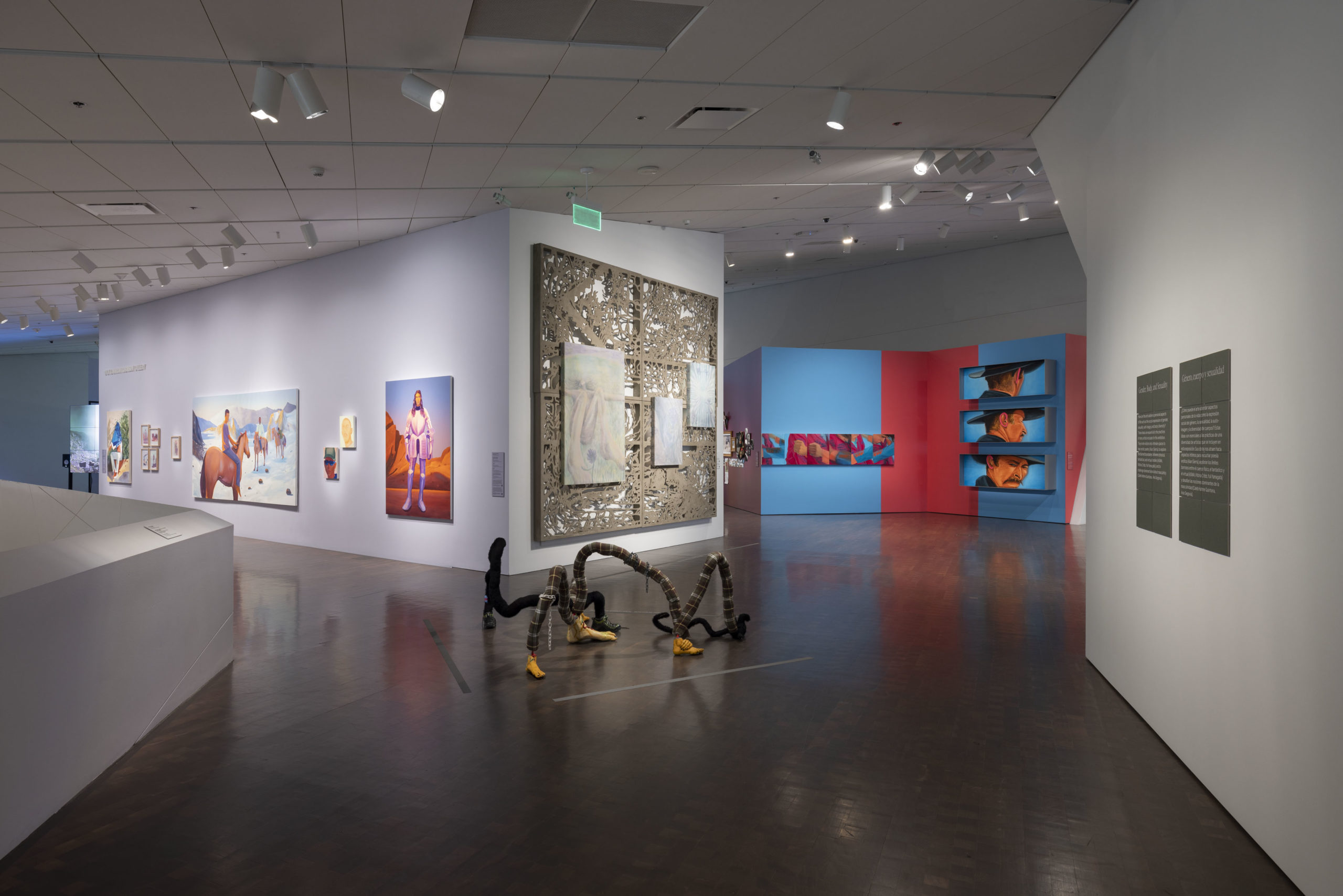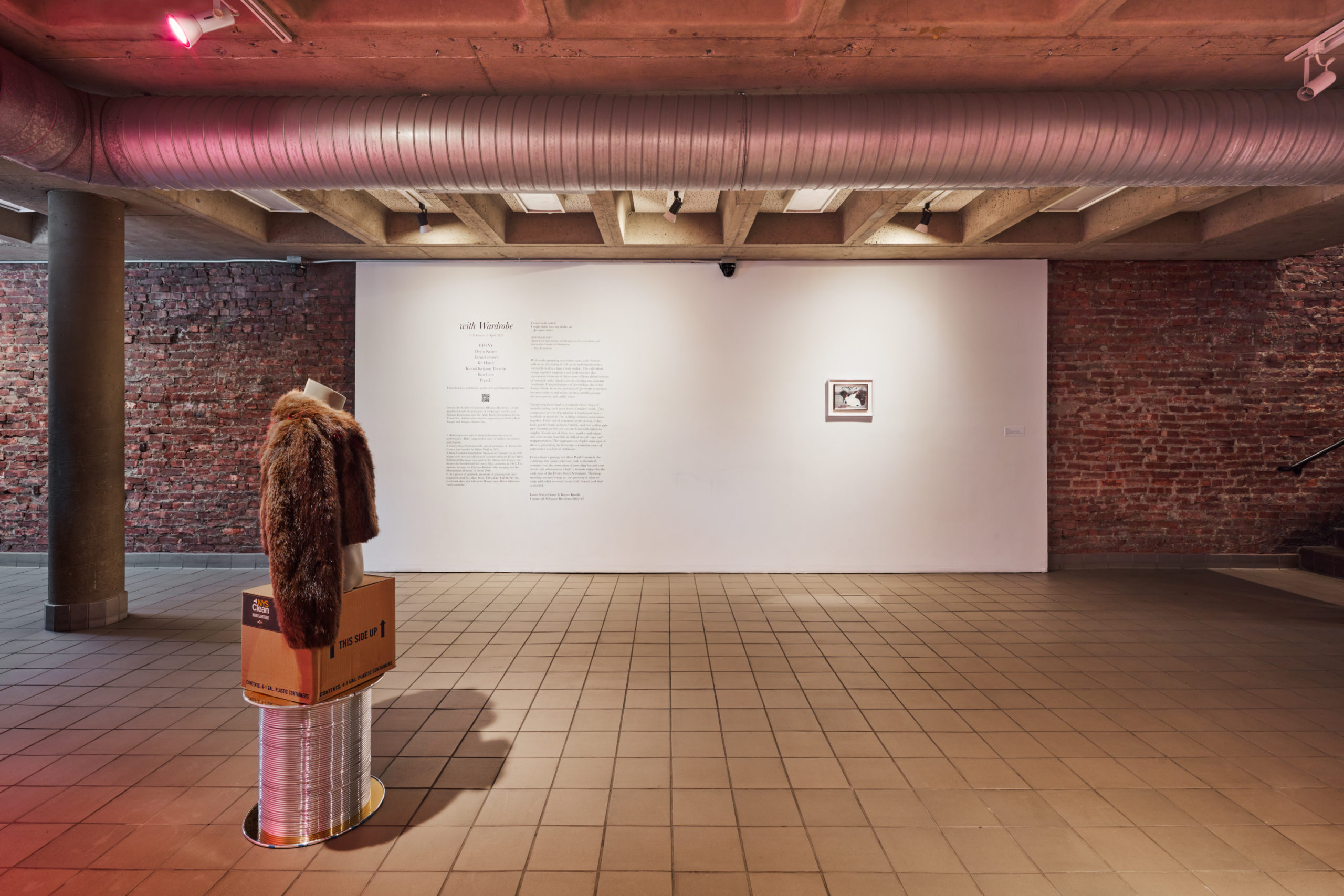
Installation view of with Wardrobe: Curatorial AIRspace Residency 2022–23 Exhibition, February 11, 2023 – April 9, 2023. Photograph by Olympia Shannon. Image courtesy of Abrons Arts Center.
Laura Serejo Genes & Kiyoto Koseki are a curatorial partnership based in New York who produce exhibitions and programs for specific sites, building upon existing systems to draw new social, material, and historical connections. As Curatorial AIRspace Residents for 2022-23 they present with Wardrobe, a group exhibition at Abrons Arts Center featuring works by CFGNY, Devin Kenny, Erika Ceruzzi, K8 Hardy, Keioui Keijaun Thomas, Ken Lum, and Pope.L. The exhibition is on view through April 9, 2023, with performances by Keioui Keijaun Thomas on April 4 and Devin Kenny on April 5.
Interview by Brandon Johnson
This exhibition explores a complex intersection of art, fashion, and performance via a collection of artists that “incorporate elements of dress sourced from global systems of material trade.” How did your curatorial duo link up, and what paths led each of you to this cultural intersection?
We are both coming to curation as artists (and friends), but we see our curatorial endeavors less as an extension of our artistic work, and more as a natural outgrowing of the conversations we have maintained over the years. We share an interest in modes of indexing, and the form of the exhibition lends itself well to relational thinking across mediums and time periods.
As temporary “residents” of Abrons Arts Center, it was important for us to critically analyze the history of the neighborhood and the institution itself, both for ourselves and for the exhibiting artists. This was facilitated by the fact that the parent institution of the center, Henry Street Settlement, has played a significant role in the community for over a century. In particular, we gravitated towards histories of local garment production and the theatrical costumes that were collected from the Playhouse Theater. Some may be surprised to learn that The Costume Institute at The Metropolitan Museum of Art was actually started by founders of the historic theater, or that early garment manufacturing in the Lower East Side was done in the homes of workers until larger factories replaced this model.
Thematically, we were also thinking about dressing as an aesthetic act that we all participate in when engaging in public space—clothes as the medium that carries us between private and public spheres. Continuing that line of thinking, garments also act as signifiers for specific communities and social categories themselves might be thought of as “byproducts” of commercial enterprises. In a way, dressing and/or undressing is inevitably performed inwardly and outwardly.
I love the fundamental connection of this exhibition to the history of the site at which it takes place. In fact, the title of the exhibition, with Wardrobe, is sourced from a passage in Henry Street Settlement’s founder Lillian Wald’s memoir. In a greater sense, what role do you see history playing in the practice of curation? And more specifically, how did it play into your thinking and planning for this exhibition?
“Site” can be a bit broad as a term and it often describes spatial conditions alone, but you could think of “neighborhood-specificity” or “institutional-specificity” as a way of acknowledging a local history. For us, the site has to be material, temporal, and social.
That being said, our intention wasn’t for Lillian Wald’s memoir to serve as a central reference; we like how literary cues refer back to a source while taking on a life of their own. “With Wardrobe,” which refers to the inclusion of coat check with admission to an event, is also a phrase no longer in popular use—a fact which lends it an interesting ambiguity. Both in theater or at a special event, the act of shedding a layer can reveal and activate another. This idea of layering comes up as a recurring curatorial strategy as well.
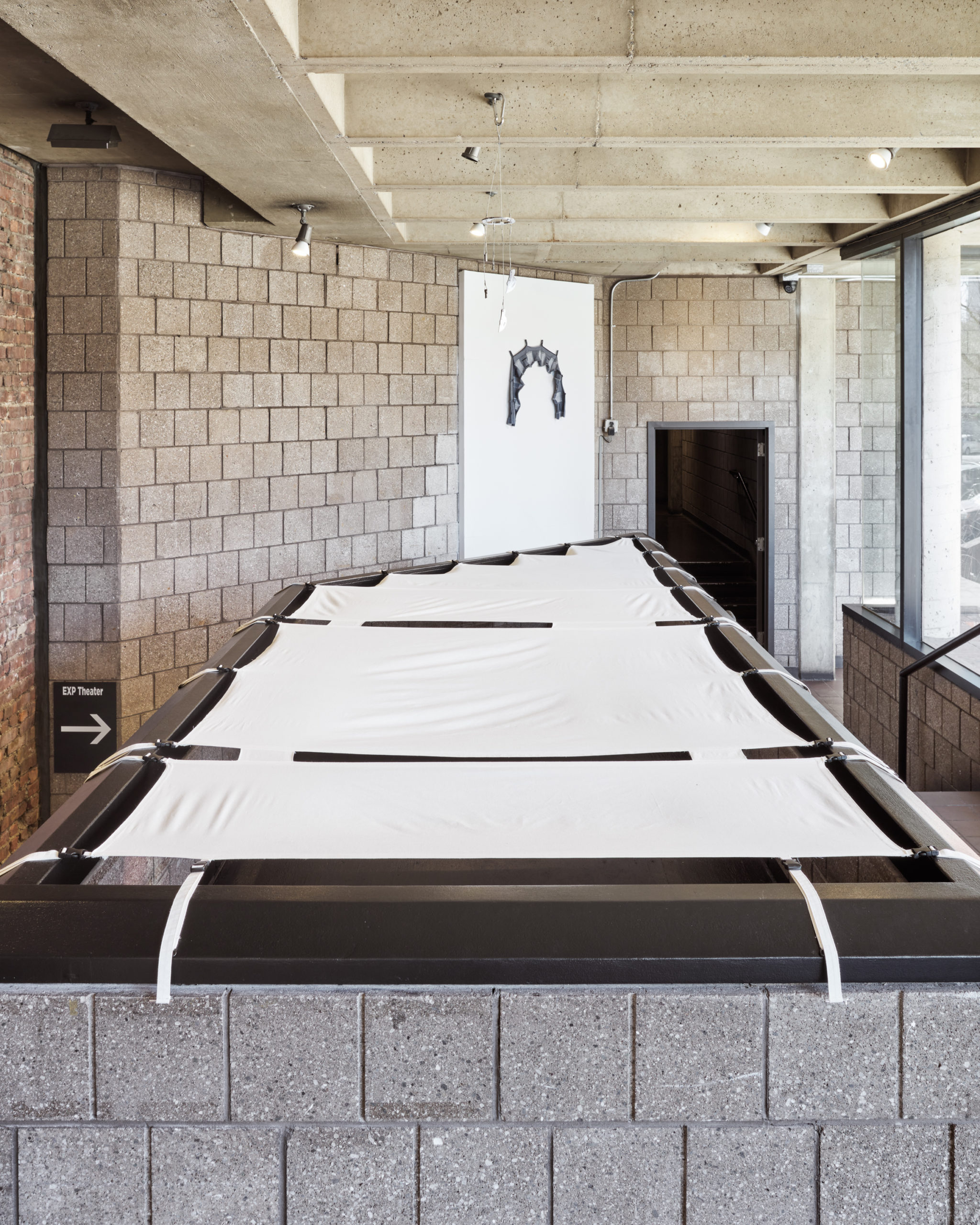
Installation view of with Wardrobe: Curatorial AIRspace Residency 2022–23 Exhibition, February 11, 2023 – April 9, 2023. Photograph by Olympia Shannon. Image courtesy of Abrons Arts Center.
While at the exhibition I took note of site-specific installations by Erika Ceruzzi engaged with as you say “idiosyncratic architectural details” within the Abrons Arts Center exhibition space. And with further reading I now understand that CFGNY’s installation The Family (2023) is also site-specific, making use of antique wooden chairs from Henry Street Settlement. Being a sucker for site-specificity, I commend you and would like to hear more about your collaboration with these artists to execute these works . . .
We clearly are too! We set the field for the exhibition at the center to include Henry Street Settlement and its headquarters, which is housed in three conjoined 19th century buildings. This was another form of thinking about connections through time as well as space. We originally approached CFGNY to exhibit a selection of items from their clothing line, but the collective became very interested in Lillian Wald’s progressive politics and lifestyle, and the framing of her story within queer history. (Henry Street Settlement was recognized by the New York State Historic Preservation Office as a LGBT Historic site in 2021.) Using antique chairs from the headquarters, they created a circular arrangement that seats 25 unique stuffed animals, recalling the chosen family Lillian lived and worked with. The combination of cartoonish characters, Colonial-style furniture, and Brutalist architecture creates a temporal mashup that bridges decades.
On her first site visit, Erika Ceruzzi expressed interest in an interstitial space alongside the stairwell to the Upper Gallery. This “tub” was a perfectly de-programmed space, in the sense that most of the employees and modern users of the building could not say what the space was originally intended for. Responding to this site, she made a work out of muslin, the material used for making clothing patterns. It’s beautifully taut. She used nails, plastic buckles, and decommissioned machine hardware to provide this particularly satisfying tailored look—a soft service for a hard architecture. Erika collected the hardware accessories seen across the works during one of her residencies at a sock factory where she produces custom tube socks, a commodity that reoccurs in her work.
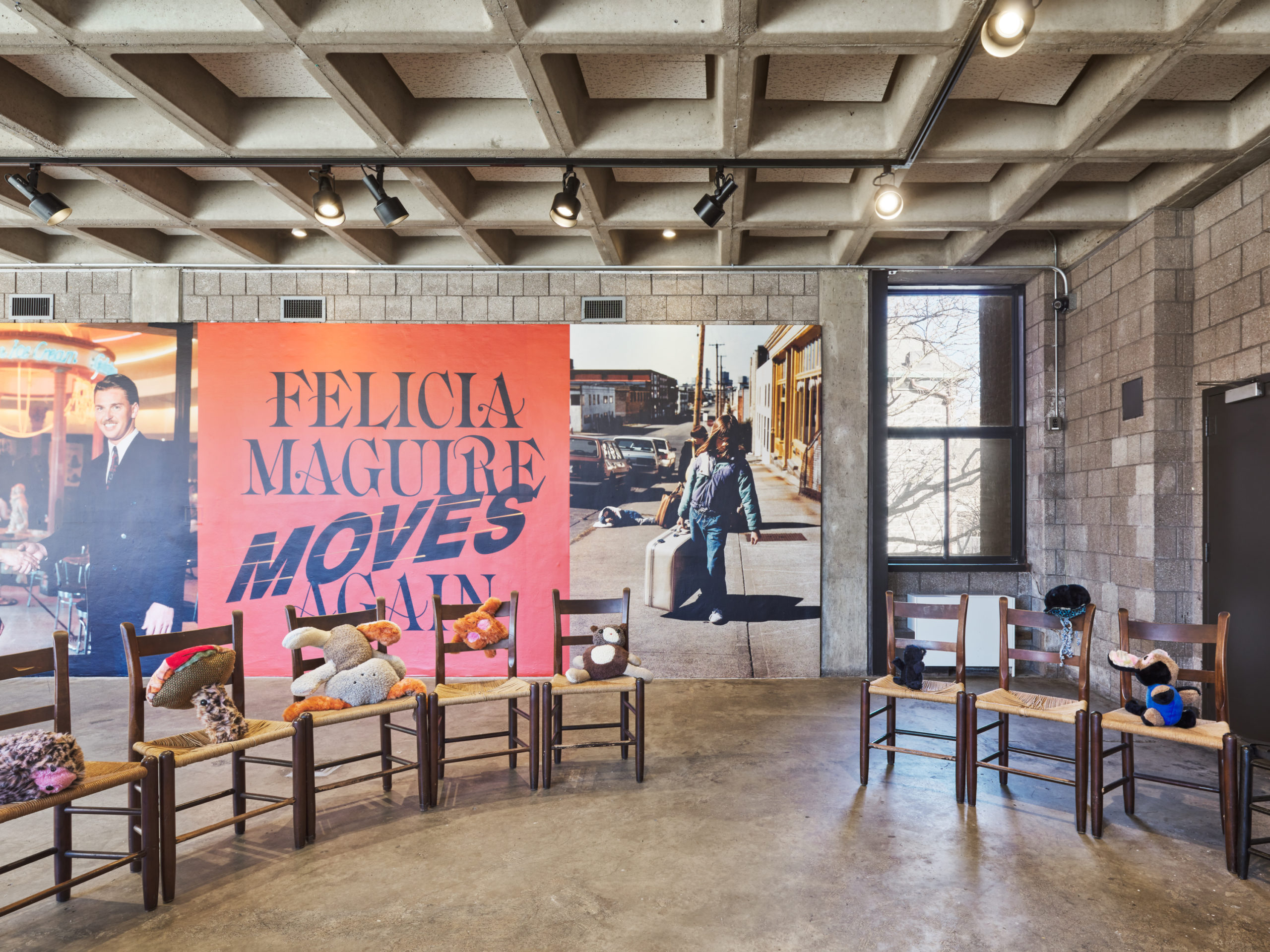
Installation view of with Wardrobe: Curatorial AIRspace Residency 2022–23 Exhibition, February 11, 2023 – April 9, 2023. Photograph by Olympia Shannon. Image courtesy of Abrons Arts Center.
On that note, what was your process for selecting the rest of the artists? Did you observe a trend that fed into your thinking around the show that these artists demonstrated? Or did you search out artists who interested you and then shaped your thinking in more of a feedback loop? In either case, curious as to how this roster came together, as well as how you feel the concerns of this exhibition relate to our current culture and society at large…
The selection process was quite mixed and it was shaped over some months, as we wanted to allow the site to feed back into our decisions. We were also mindful of how the center has framed art as a social service or as “arts for living,” which made us think about the exhibition in relation to community health, both in subject matter and in practice. This made Pope.L’s work important as a reference, as it explicitly responds to social ills, including what he describes as conditions of “have-not-ness.”
We gravitated toward Ken Lum’s work due to its reference to advertising and its ability to work on a scale that would take advantage of the visibility of the gallery walls from the street. In our conversations with Ken we learned that part of his family lived in the Lower East Side, right on Henry Street for some time after emigrating from China. Small, yet sentimental, details like this aided in our decision-making.
Although she is originally from Texas, K8 also has deep ties to the Lower East Side. Her work embodies the idea of “trendsetting” with a true humor and confidence that feels particular to the downtown scene and important to capture for discussion. Her monumental Untitled Runway Show, which was presented at the 2012 Whitney Biennial, continues to influence the art and fashion worlds alike, and we knew we wanted to exhibit at least a pair of “looks” from the collection.
Overall, we are especially happy with the lines of connection made between the artists and works that could not have been predicted. These connections feel both in and out of our hands in some regard, and maybe some of the magic is in this unpredictable constellation that forms as small decisions are made with a loose but larger picture in mind.
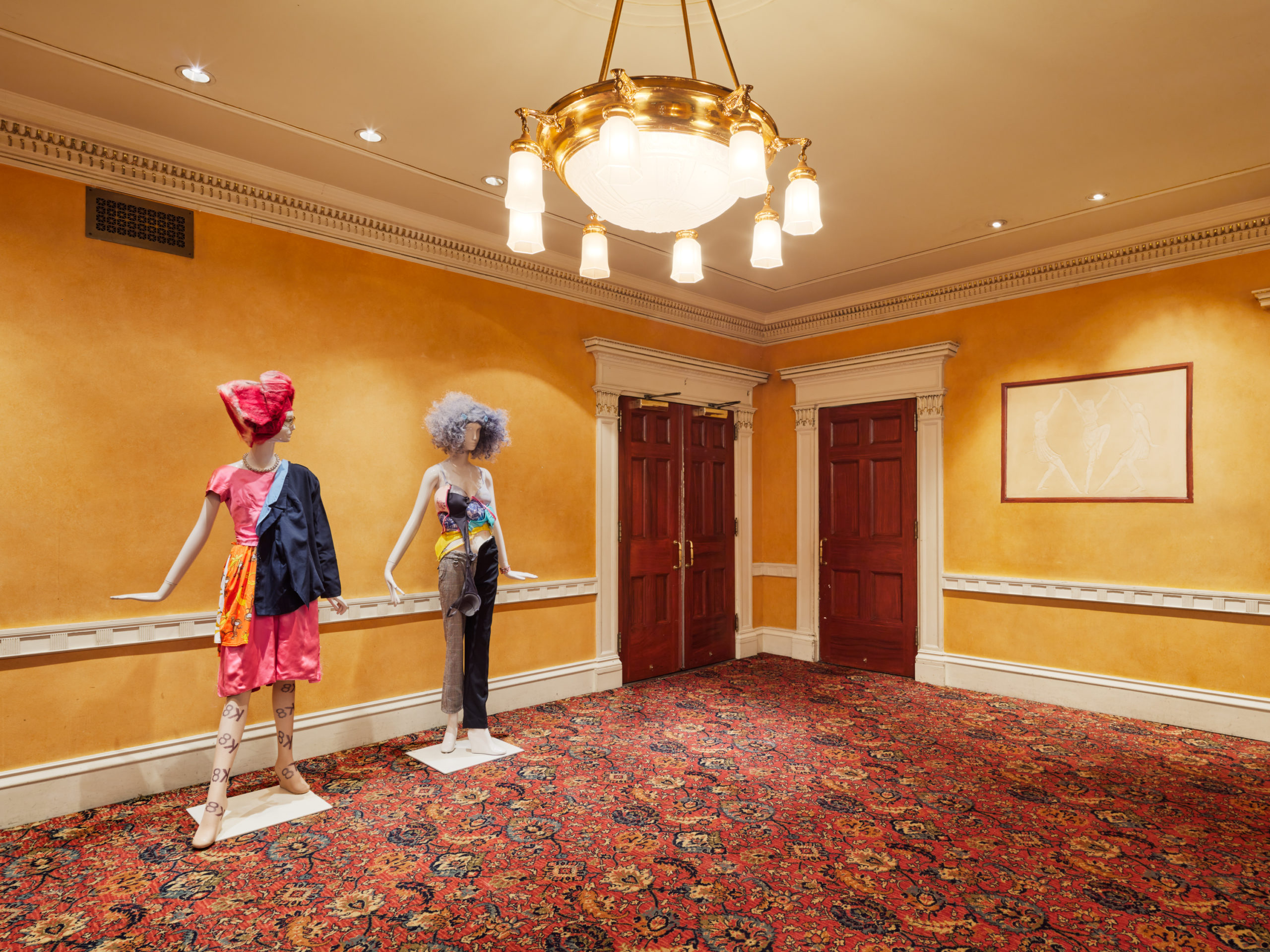
Installation view of with Wardrobe: Curatorial AIRspace Residency 2022–23 Exhibition, February 11, 2023 – April 9, 2023. Photograph by Olympia Shannon. Image courtesy of Abrons Arts Center.
There will be two performances: Keioui Keijaun Thomas’s Come Hell or High Femmes: The Era of the Dolls and Devin Kenny’s “It’s the new style!” or “No more aggregatekeepers”. What role do these performances play in with Wardrobe?
We are very excited for these performances, as they expand upon the artists’ contributions to the exhibition and allow them to present concepts latent in their sculptural work in a more interactive manner. The venue also offers a unique opportunity to extend the exhibition into spaces designed for performance. It’s a special touch that the theater-goers have to walk through two levels of the exhibition to make their way to their seats. The architecture really served us well in all its idiosyncrasy—we can thank the architect, Lo-Yi Chan for that!
Finally, seeing as the exhibition was the result of an annual curatorial residency at Abrons Arts Center—what did you learn from this experience as curators?
The multifaceted context of the center challenged us to consider audiences in a different way, beyond the commercial or academic formats and tones we were more familiar with. While the exhibition exists as a backdrop to a buzz of activities taking place daily at the center, it can also serve to redirect one’s path or one’s gaze. We welcome this overlap of dedicated and serendipitous experiences, as it supports our interest in generating unexpected connections between artworks and their sites of display. These conditions allowed us to think more broadly about physical and figurative access points throughout the exhibition, taking into account the sizable windows and views from the street.
Our residency actually continues with a group exhibition opening in June at CC Projects on Allen Street featuring the work of Alex Dolores Salerno, Emily Manwaring, Nina Macintosh, and Shirt—current artists in residence at the center. There is definitely a shared experience across all users of the center and it will be interesting to see how this comes through off-site.
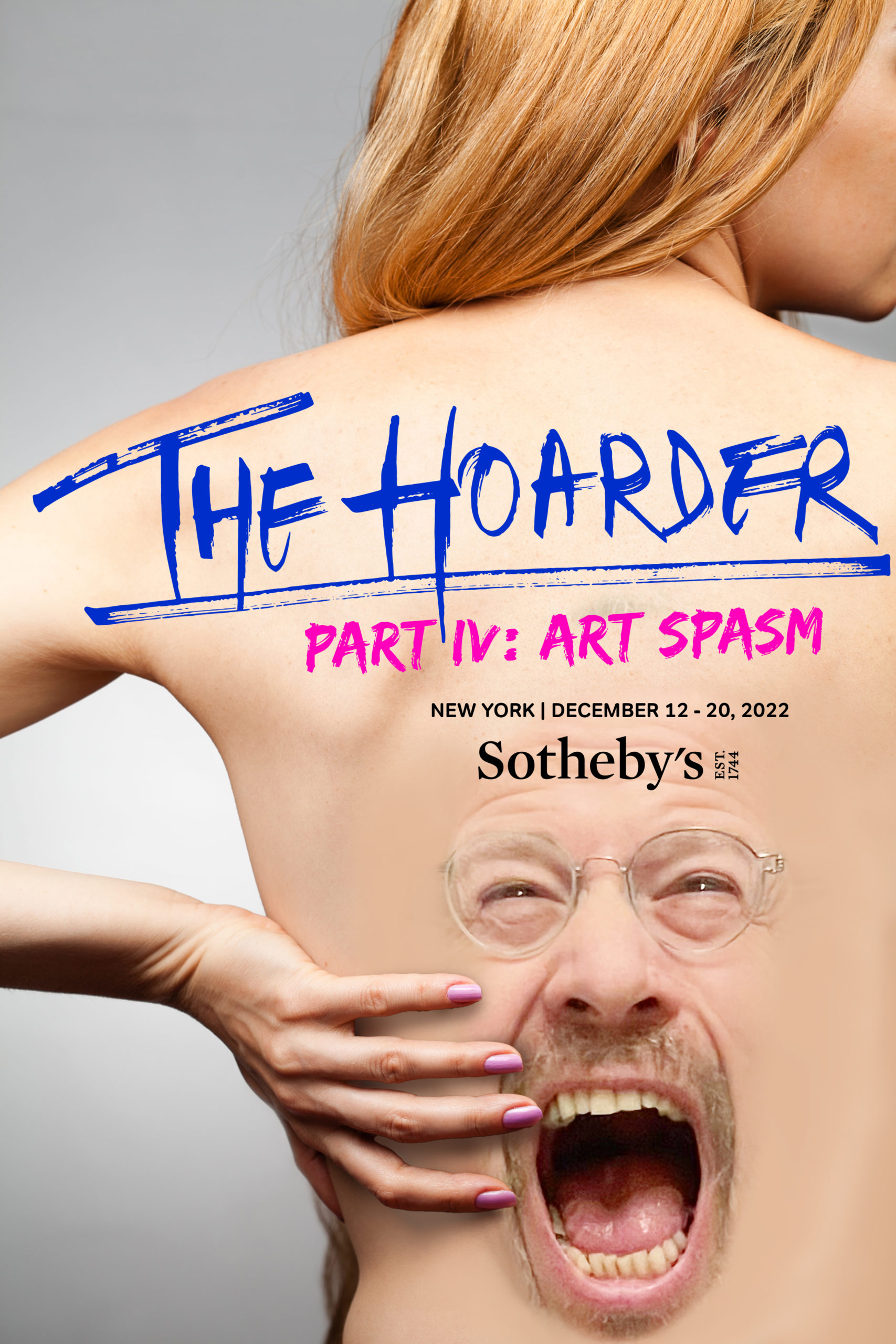
Kenny Schachter’s The Hoarder IV: Now Or Never sale will happen with Sotheby’s New York from December 12-20, 2022.
Interview by Devon Dikeou
Can you talk about the concept of Hoarder IV (already the fourth edition!) your sale at Sotheby’s—how did the idea get hatched?
I lived in London for 15 years before moving back to New York in 2019. When I took stock—or tried to—of the task of packing up my residence which had become inundated with stuff to the extent I thought the house would sink into its foundation, or I would be suffocated to death by my possessions, it was nothing short of daunting. And a little shameful. The idea occurred to me that a chunk of the art and design would be better served with new buyers that could cherish the works as I had. Before I got buried. Hoarder is a pejorative term for accumulating art which instantly appealed to me. And having utterly no reserves, unheard of in the auction world, seemed a great way to make art accessible to others that may not be in a position to afford to forge a collection. My loss is your gain.
How does one reconcile selling if one’s a hoarder . . . It seems counterintuitive . . .
Trust me, there’s never an empty wall in my house—even after 72 works were recently picked up from my place in NY. And that constitutes less than half this year’s sale. My storages have storage. I am materialistic yes, but ascetic too: as long as there is something I love to replace an object gone missing, I am copacetic. I don’t get too attached to individual things other than a handful of artists that form the core of my passions and interests. Plus, buying is addictive—it’s one of my only vices left at this stage of my life (other than cookies)—so there’s always incomings. And yes, I fully recognize the extent of my unresolved “issues.”
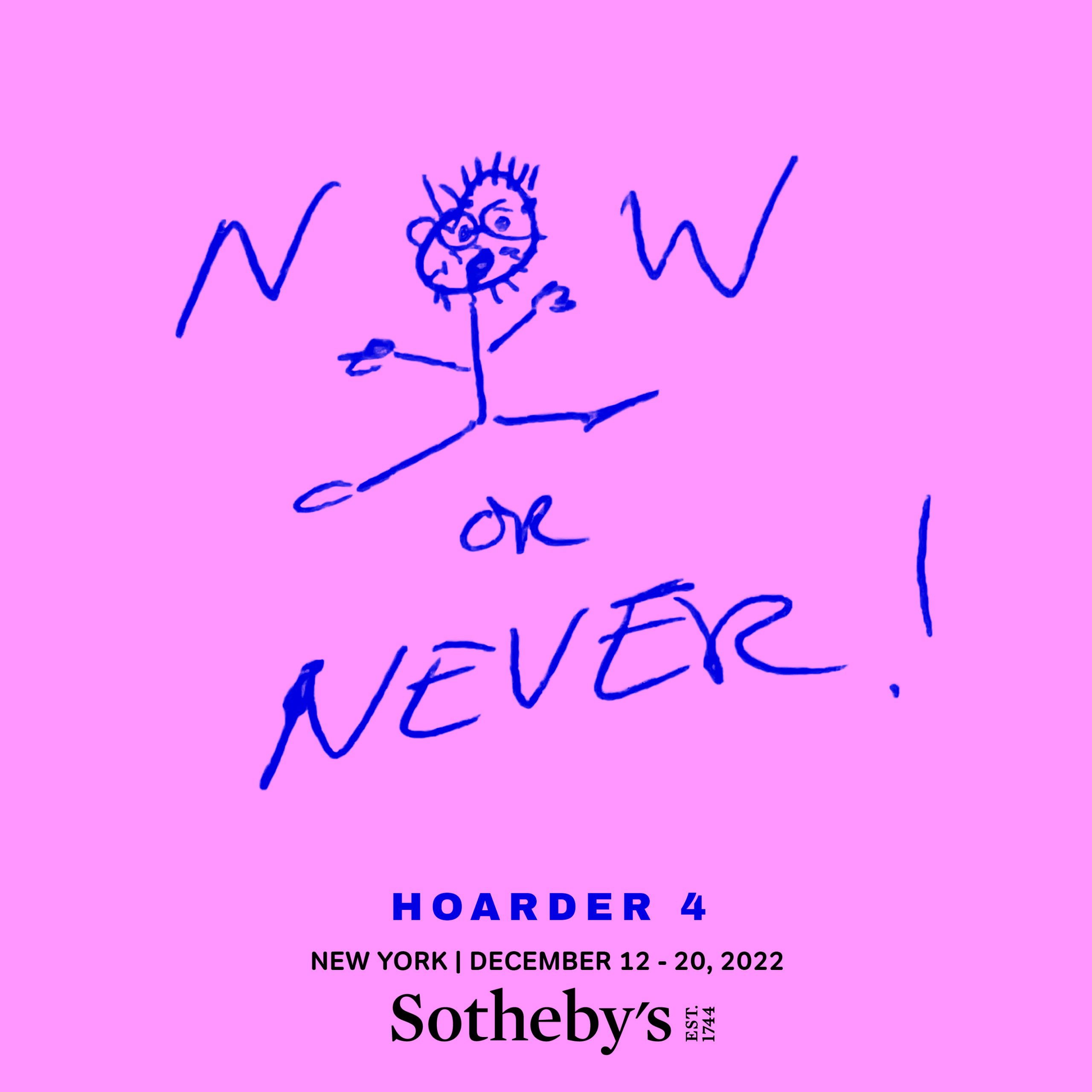
How does one decide what’s in the sale vs what one holds back?
Timing is important (i.e. when I bought something) so as not to get branded as a flipper though I am very laissez faire in life and think it’s normal for people to change their minds when it comes to ownership and don’t begrudge others who sell my art. Also, of all the works that have recently departed my hoard, there are things I couldn’t yet do without as they fulfill a function in my thought process at a certain point in my life.
How many of these sales have you done and how many should we expect?
This is the fourth and I planned to have it as the last but alas, I can’t really make a fulltime living from my art, writing and teaching (unfortunately), so what choice have I? Stay tuned for Hoarder V.
How does your specialty NFT’s figure into the mix . . .
It doesn’t . . . exactly. Though (I am full of self-contradictions) I am doing a mini-hoarder NFT sale with Lempertz Auction House in Germany on December 3rd. With no reserves (of course) and 13 lots.

Is the sale an art piece?
Everything I do—teaching, writing and making things—is in some sense related to my art process, a kind of performative exercise in self-sabotage.
Why Sotheby’s over Christie’s . . .
I had a nihilistic friend working at Sotheby’s in 2019 and he laughed when I proposed naming the auction derogatorily in relation to the stuffiness of the art world. At the time, online sales were the lowest of the auction hierarchy; one small step above selling your wares on a blanket on a street corner. So no one really took notice or cared. Then, in the face of the pandemic, online became the only way to transact art—for buyers to get their fix. At that point, Hoarder was already launched and as far as auction houses are concerned, if there’s a market for soiled underwear, then knickers they will sell. As long as my shit keeps selling, I’ll continue to have a platform and free reign.
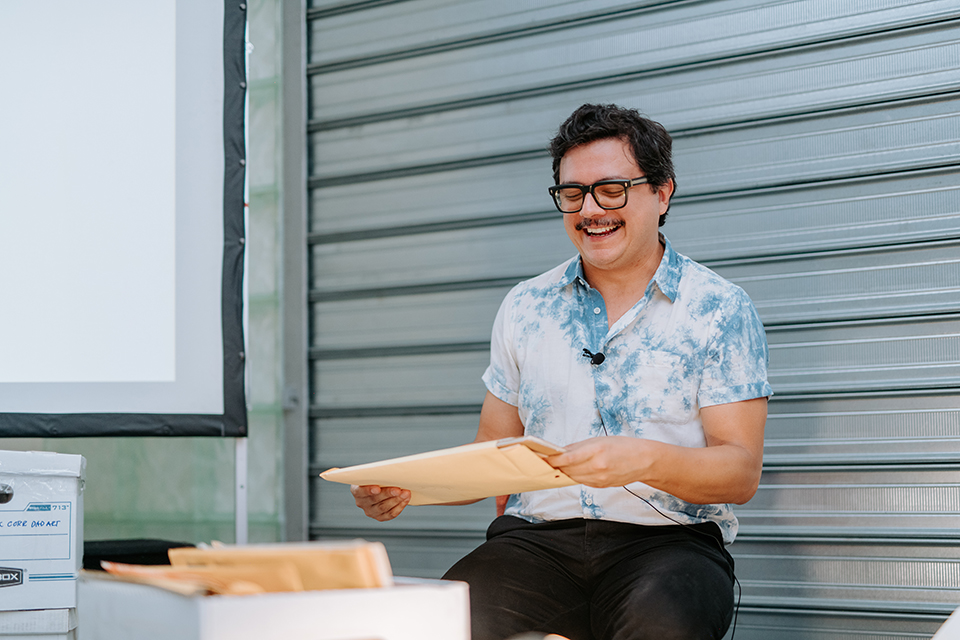
Photo: From the Hip Photo
Josh Franco is an artist, art historian, and former zing contributor from West Texas. He has exhibited across Europe and the United States and will be publishing his first book, Marfa, Marfa: Rasquachismo and Minimalism in Far West Texas with Duke University Press later this year. Franco joined the Archives of American Art in 2015 as the Latino Collections Specialist and was recently appointed the Head of Collecting. On September 8, 2022, he sat down with Devon Dikeou for Archive Live—a series Franco conceptualized that puts artists in conversation with archivists and the public—to discuss her personal papers before they are sent to the archives in Washington D.C..
Interview by Paige Hirschey
The AAA has such an expansive mandate—to document the history of art in the United States—how do you determine which artists fit into this history? What goes into that process and who is a part of that conversation?
We have a thorough collections plan, most recently updated in July 2021. The plan is informed by our previous decades of collecting as well as rigorous discussion among staff (many, many drafts sent back and forth in the process). This collections plan lays out the intellectual framework and seven broad themes that help us organize our thinking when considering a new collection: lives of artists; research and writing about art; arts organizations; art market; patronage; art instruction and services; and miscellany. To quote the document, “While collections must have high research potential, as a national repository, the Archives seeks to represent the geographic scope, as well as racial and ethnic diversity, to build a representative picture of the visual arts in the United States.” I want to emphasize that this scope goes beyond the artists themselves and includes fabricators, critics, collectors, curators, and art historians as well.
I love the concept of Archive Live and sharing that exciting moment of discovery with an audience who might not be familiar with archival research. Can you tell us a bit about how the idea for those events came about?
I remember exactly how this came about! Sometime during my first couple of years at the Archives, when my role was Latino Collections Specialist, I realized how profound the experience of the collectors can be. We spend so much time working closely with accomplished arts workers poring over often quite personal documents. This inevitably brings a level of intimacy and deep historical knowledge that is not the typical classroom or museum experience, or even the reading room experience, where researchers have direct access to the materials, but not their creators. It felt very unfair that the tiny number of us who do this work got to have that experience, and I wanted to figure out how to share it with bigger audiences. Thus, Archive Live emerged as an idea, and I am happy to have conducted them with Paul Ramirez Jonas (our pilot and a Dikeou Collection artist!), Andres Serrano, Vincent Valdez, and most recently of course, Devon Dikeou.
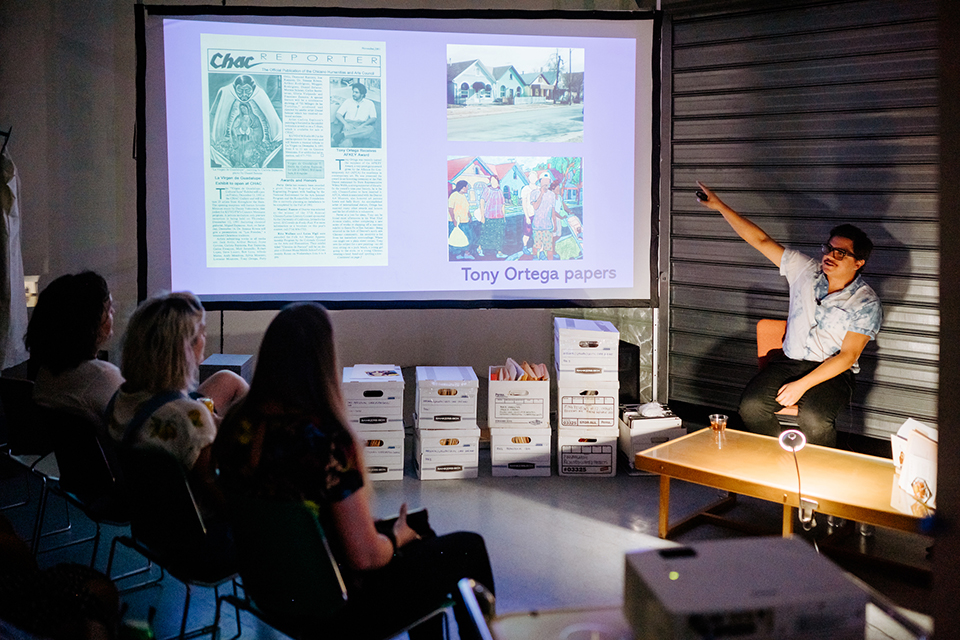
Photo: From the Hip Photo
At our Archive Live event at the Dikeou Collection, you showed the audience the letter in which Marcel Duchamp offhandedly coined the term “readymade,” which underscored how important archives are in terms of preserving materials that may seem insignificant at the time but ultimately shape our cultural history. This impulse is also central to Devon’s practice, in the sense that she foregrounds the documentation of her own personal and professional history. Does that shape the way you’re deciding what material of hers will ultimately go to the Archives?
There is an extra layer of interesting complexity when collecting the papers of an artist whose medium is itself the art world. Like Devon in her practice, the Archives is concerned with documenting the social networks, notable figures, and institutions that give form to the visual arts. All of the records created by Devon—from her own practice, zingmagazine, and the Dikeou Collection—perform this function, so in a way, it’s like we are nesting the archive she and the whole Dikeou team have created within ours. Worlds inside worlds, is one way to think of it.
On a related note, I would imagine that Devon’s work is presenting some interesting questions vis-a-vis categorization. How do you differentiate “art” from “archive” in a body of work where they so frequently intersect? Is this something you’ve encountered before?
Yes, we encounter this with some frequency in fact. It’s often something the artist hasn’t had to think about before we begin conversations about the Archives. Our base policy is that it’s up to the artist first to determine what is artwork and what is archival material. Once they make that determination, we see how the identified materials fit or don’t fit into our collecting scope. Because Devon has put so much energy into documentation and thinking about this question herself, it’s actually relatively clear with her papers where the line is. That may seem counter-intuitive, but I think it’s a logical result of her practice; while someone who is, say, strictly a painter may just be thinking of this distinction for the first time, Devon’s practice, which takes documentation and administration as its central raw material, has led her to think about these questions deeply and for a long time. Unlike a painter who might be considering the status of their drawings in these terms for the first time ever, Devon has thought about these questions for quite a while, as they’re fundamental to her work.
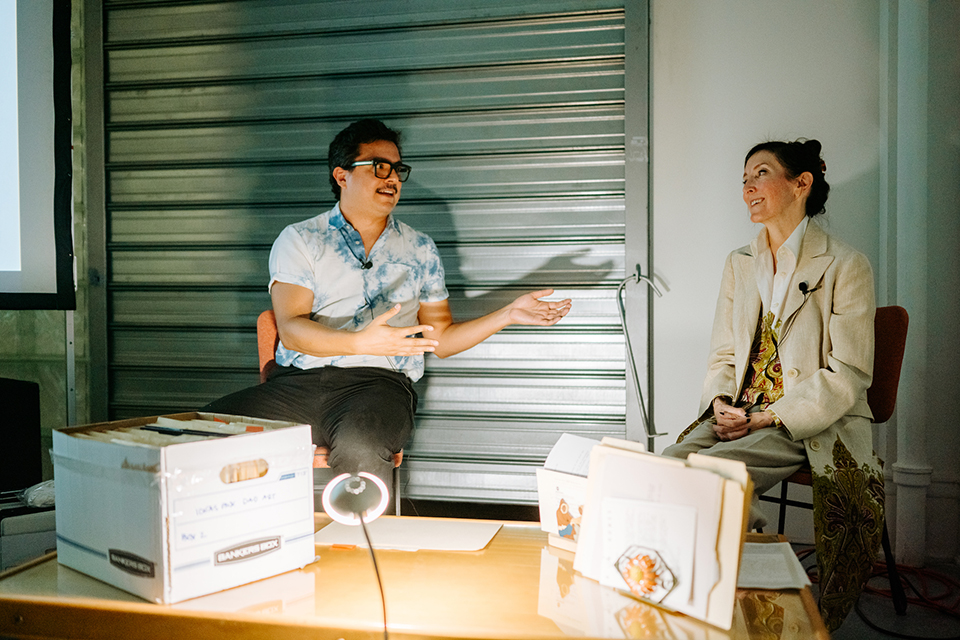
Photo: From the Hip Photo
How does working with a living artist, whose practice is still evolving, affect the acquisition process?
It can be a double-edged sword. On the one hand, thinking again about Archive Live, it is invaluable to have the artist available to provide greater context for a collection, as we can document that additional information and make it part of the record, benefitting researchers down the road. On the other hand, undergoing this task while still active compels an artist to think of themselves in the historical long-term, which can do some strange things to one’s sense of self in time, not to mention one’s mortality. Again though, based on her practice, this kind of thinking seems to already be integral in Devon’s approach to making art, so I’m not worried about any kind of de-railing in this instance. In fact, I imagine the whole process could be incorporated into a Dikeou artwork in the future—what would Devon do with our shelving system? Our Finding Aids? Our Reading Room protocols? It’s conceptually rich, but also just a lot of fun, to imagine these possibilities.
Devon has worn many different hats in the art world, she’s an artist, editor, and patron, she’s worked in galleries and has an international network of art world contacts. How do you think this might inform the ways that future scholars will use her papers?
That’s exactly why I feel a sense of urgency around this collection. Some of our most frequently accessed collections are those created by figures who create worlds unto themselves through insatiable curiosity and a compulsion to document and gather ephemera. I am thinking of the Lucy Lippard papers and the Tomás Ybarra-Frausto Research Material on Chicano Art, which are perennially in the top 10 of most used collections, out of around six thousand. This is because Lippard and Ybarra-Frausto, when you look at their bios, dedicated their lives to building networks and continually connecting and re-connecting different nodes in those networks…and holding on to all the associated scraps of paper generated and gathered along the way. They are multivalent, with an entry point for nearly any aspect of art history in the United States someone might be thinking about. What’s striking in Devon’s case is that she is herself an artist, which is not the case with Lippard and Ybarra-Frausto. I am eager to see what uses the Devon Dikeou papers, zingmagazine records, and Dikeou Collection records are put to in the future. Devon is not only an artist’s artist, but an art historian’s artist too.
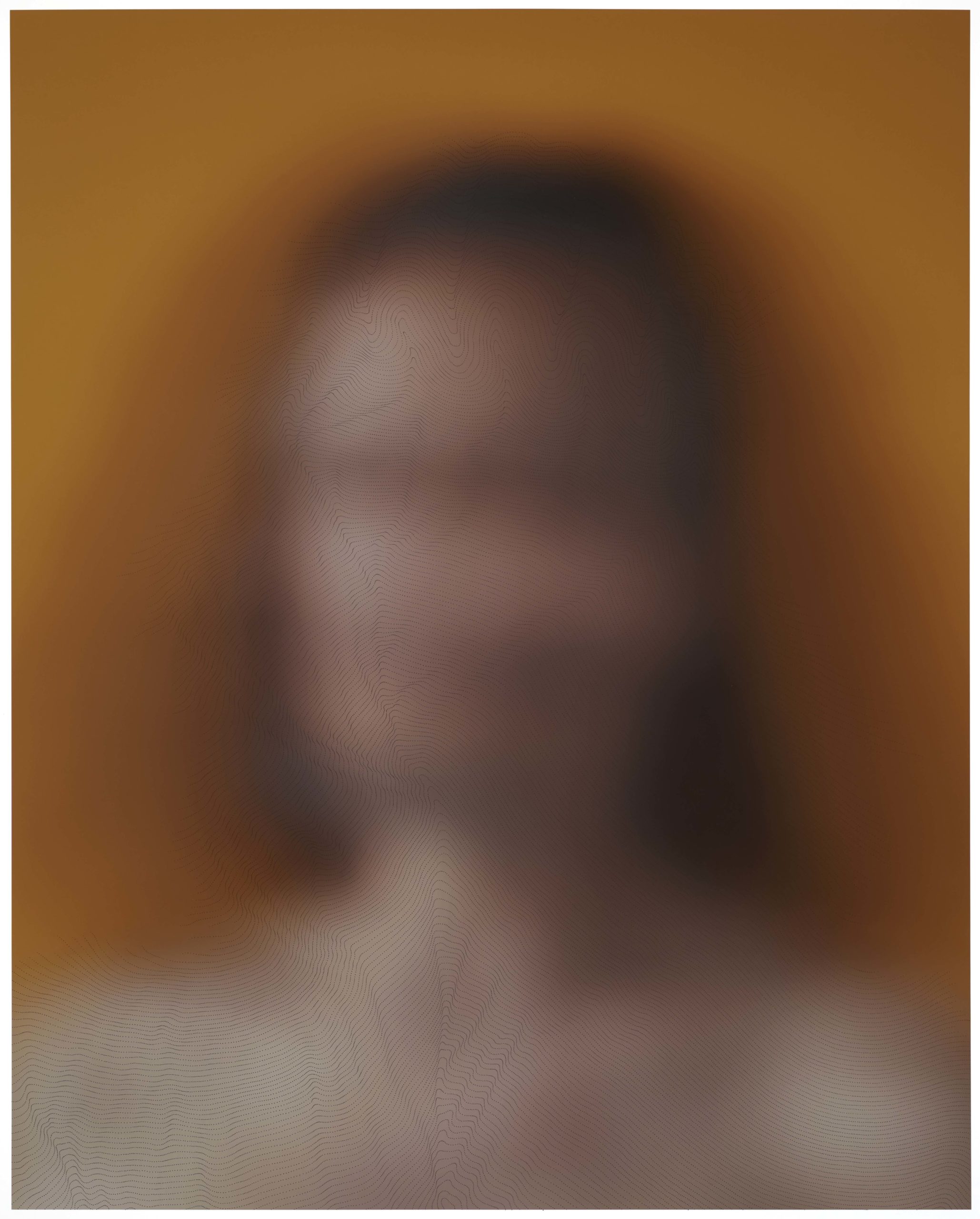
New Portrait: Pedro 1, 2022, ink on archival digital pigment print on paper, 36 x45 inches
These questions are posed to Sebastiaan Bremer on the occasion of his fall exhibition, New Portraits, at the Edwynn Houk Gallery in Midtown New York, on view September 6 – October 1, 2022. All works courtesy Sebastiaan Bremer and Edwynn Houk Gallery NYC.
Interview by Devon Dikeou
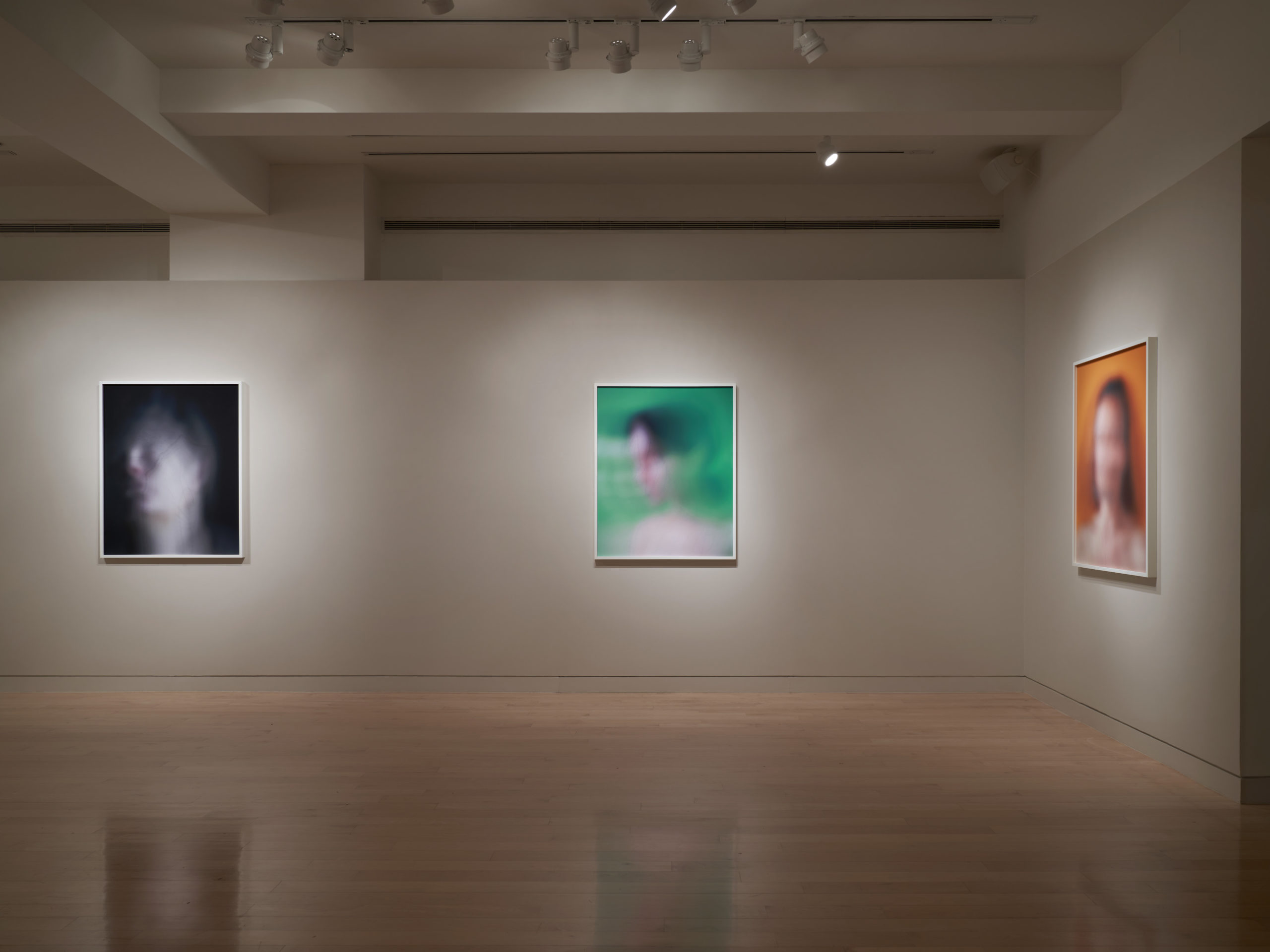
Install Shot, New Portraits, September 2022, Edwynn Houk Gallery, photography by Fyodor Shiryaev
When I visited your studio once you were working on this series and as we were talking, you were working, so talking and working . . . And you had a turntable going. I can’t remember the song or LP but it was a wonderful moment of process intersect . . . Could you speak about that process and intersect? How you come up with the conceptual model, create the parameters, and then set about physically combining the two . . . What is the music that makes that happen . . .
My works take a very long time to make. As the drawing and painting on the photographic print takes shape, I slowly make tiny marks with ink while the outside world filters in. Weather and light make a strong impact on me as well, since my studio has a lot of natural light. I see the sun move through the sky all day. This is not ideal for working with photographs, especially glossy ones, but I love it. The news, tremors, moods and music all end up inside the drawing. I don’t plan this, it happens to me. When I started working in this mode of combining photography with painting and drawing around 1999, this blending occurred organically, and I have embraced it wholeheartedly.
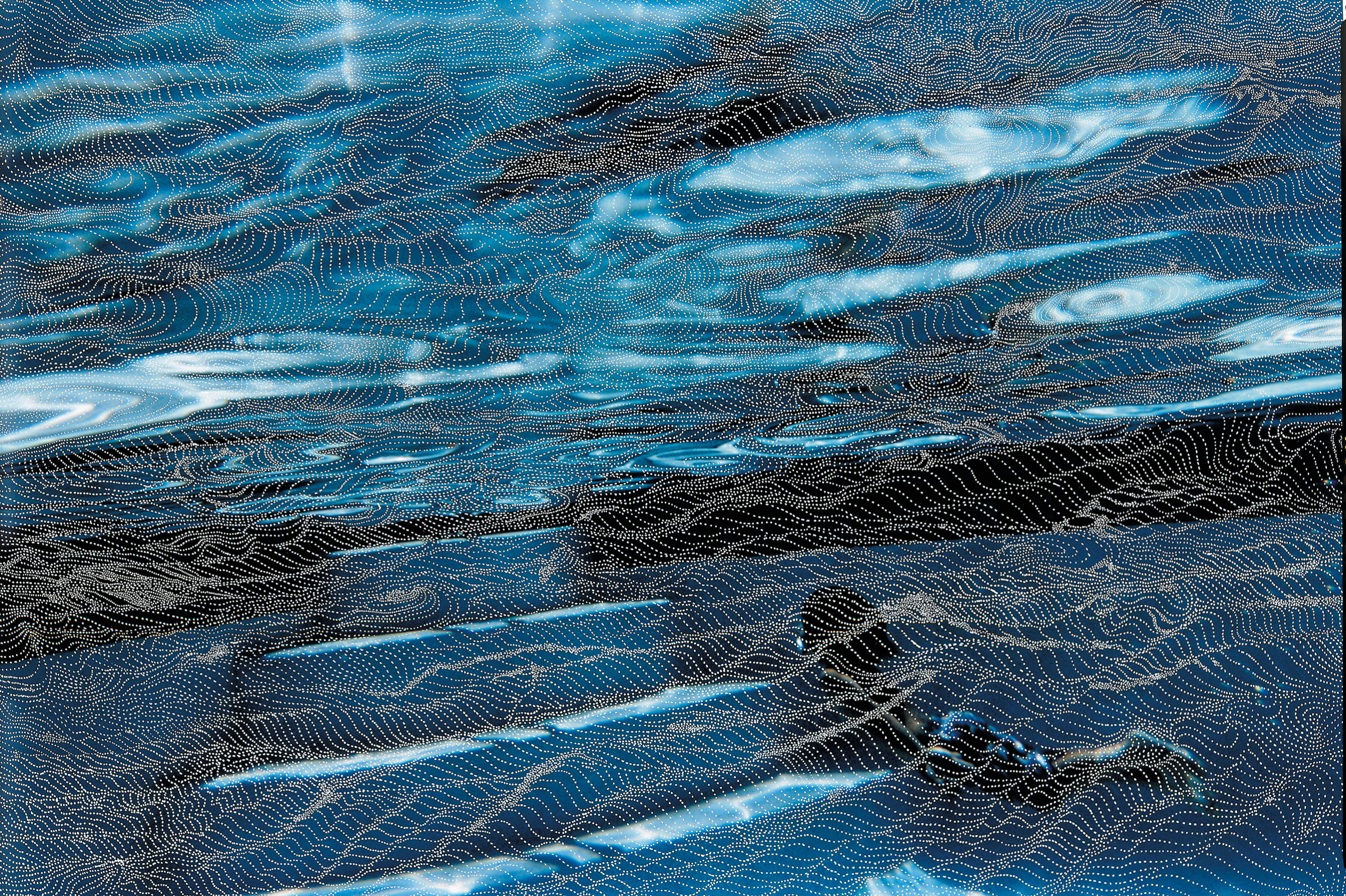
I Held My Breath for 13 Hours Afraid She Wouldn’t Come Home (Pool II), 2000, Unique hand-painted chromogenic print with mixed media, 40 x 60 inches
The idea I start with is morphed into another form and so on and so on. It is similar to bricklaying in that the first brick in a wall informs the position of the next. In music the chord progressions and sequences of notes or beats eventually take shape and form a structure. It can be very surprising to see what appears. Of course, I do set parameters and have certain goals on the outset, but I am open to accidents and surprises. This makes it exciting and confusing at times. There is a parallel to the recollection of dreams: you must have created them but did not control the story somehow. I sometimes have a playlist to set a mood or form an idea—and then I record it within my mark making subliminally and literally. The music of Miles Davis I play often, and the Band of Gypsys album by Jimi Hendrix is excellent for rocking me out of a rut. There are also periods where I work in quiet, or listen to podcasts. When I was a teenager I was always drawing, and when I was with friends I often drew while conversing—it was my thing. I still to this day enjoy talking on the phone or having people over while I work—this does not work all the time obviously—but I do like it. My practice is very solitary and I am a social person. To have visitors is wonderful sometimes—I work long hours and being alone can get a little much sometimes. Still, most of my work is made in solitude, with sound.
It seems to me too that in a way there’s very interesting things happening in this series, New Portraits, at Edwynn Houk Gallery, as they’re studio shots presumably and it takes a certain amount of commitment to a studio process—which creates an outcome in a medium dedicated to reproduction as part of the final outcome . . . And the images then are finished by your laborious individuated and unique treatment creating singular objects, which contradicts notions of photography as addressed by Walter Benjamin in The Work of Art in the Age of Mechanical Reproduction in a way . . . Thoughts. . .
The sources for my works vary, as I am looking for different things to express in each individual work or series. Originally, I used a lot of photographs from my personal archive and transformed them with photo dyes and other means into some interior landscape on which I then worked with small white dots made with pen, paint and/or penknife. The dots became a solution to a problem I faced: I wanted my marks to be integrated, I wanted them to enter the reality of the depicted three-dimensional space of the photograph. By making small marks I felt I squeezed in between the little blobs of emulsion instead of creating a grid or linear filter encapsulating the photograph. Another advantage was that it slowed everything down, and gave me time to think and watch as the drawings took shape. Most of the photographs I worked on were shot by me, but not necessarily made with the intention of using them as works to draw on. Some photographic prints I worked with were quite old, and I had used some as sources for the paintings I made in the early 1990s. The stains, paint drops, creases and rips that I made by accident whilst using them in my studio I incorporated later. I photographed the small prints and printed them large. I also made a series where I used small faded black and white Polaroids. They were shots of the interior of a house I lived in with my family for a few years in the early 1980s. Who took these pictures I never found out, but I think they were made for use by the architect who worked on the house we lived in from 1978-1983.
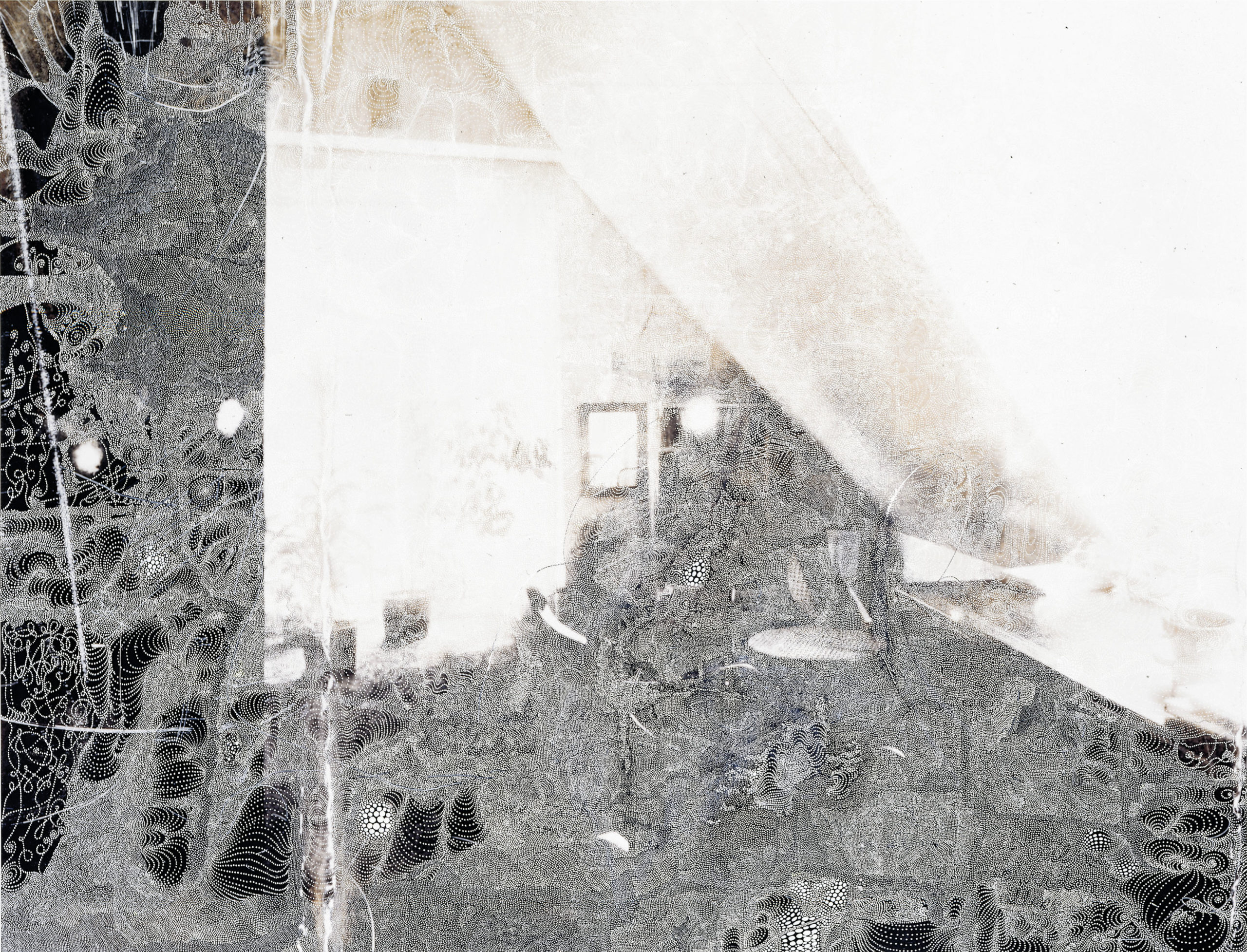
Castle (I-Study), 2001, unique hand-painted chromogenic print with mixed media, 40 x 60 inches
I re-photographed these small black and white Polaroids with a large format camera and turned them into oversized prints on which I drew. These modes of working were dominant for a few years, until at some point I was intrigued by photographic prints without using any negative. By drawing on the dark or black prints I was able to create the illusion of a photograph, a practice which I continue to return to.
I have also made a series or works using pen-knives, making marks by cutting and removing parts of the emulsion, again interfering with the underlying image and the material of the paper, creating a completely different reality and turning the photo into an object of sorts. This was also the only series where I used photoshop, in the crudest way in order to layer images. I am bad with technology and dislike working with a screen and computer. In none of my works besides that series is there any photoshopping. With a computer the possibilities are endless, and the choices overwhelm me.
I much prefer not being able to correct or step backwards and I make all the manipulations of the print with pen, acrylic paints, rips, scratches, inks and dyes.
The physical object, the photographic print with all its different surfaces and sometimes marks of wear and tear are what I love. It is another recording of time in a way. Blemishes are fine, and I have even found that the most beautiful photograph is the hardest to work on. There is little to improve. The joy of squeezing out a meaningful image by manipulating a not-so-spectacularly beautiful print by hand is wonderful.
In most works the print functions as a fully charged battery brimming with content and energy underneath the worlds I build. However, they are not the dominant factor. The image is secondary, the preciousness or meaning I sense in a photo is in some cases the foundation and the combination of my work and the underlying image create an interwoven structure.
Photographs are made for reproduction. A negative can be reprinted over and over, and the surface of a photographic print should not be messed with for archival reasons.
I practice the opposite of that. My works are paintings, in the sense that there is only one work after I am done working with the piece. Any kind of reproduction of my art is just a facsimile, since the texture of the surface and the contrast of the matte inks on the glossy surfaces in most of my works is not reproducible in any true or faithful way. Each artwork of mine is unique, and reproductions fail to capture the surface of the object I create. I do everything anathema to traditional photographic practice and I think I have a relatively unusual relationship with photography. My work lands somewhere between painting, drawing and photography. There is even in some cases a sculptural quality to them, since the surface is very much an active part of the piece. The paint drops I apply become almost like braille, and the light sparkles off the smooth surface of the acrylic. The cuts I make with X-acto knife create ridges that are clearly visible and protrude the surface, and in some cases I removed the layer with the emulsion from C-prints, exposing the white paper underneath.

Glaucon, 2014, unique hand carved chromogenic print, 50 x 36.5 inches
The New Portraits are a departure for me in the sense that photography takes a front seat. I set out to create pictures to work with, and I began by making self-portraits in my Greenpoint studio with the help of my wonderful and talented assistant Fyodor Shiryaev using only daylight. In the first attempts to make portraits I posed in front of a light blue door in my studio and used various scenarios. Most pictures were a bit out of focus and blurred, some were very much blurred because I moved (since in those instances the camera moved as well), and the shutter speed was slow. Slowly I realized what I had been looking for—a depiction of inner space and reflection. I wanted to make work that was elemental and reductive, getting to the strange inner worlds and experiences we all experience, and of course even more so in the period following March 2020. Part of the idea was to get to the heart of some new realities: isolation, solitude, a strange registration and experience of the passing of time. The other reality is our interconnectedness and our dependence on our context, our surroundings. Every moment was stretched in time, silence gave a lot of space to rumination, but still we are all very much in our moment, in our surroundings, blended and rooted in our present but it is very hard to continually realize, practice and observe this. For those and other reasons I posed with eyes closed, although that is hard to see in most images because of all the blurring. After working so much on just self-portraits, and eventually being surrounded by my own head everywhere in my studio, I realized that it wasn’t so much about me, or my experience, but much more about a shared experience and really about all of us, anyone, anywhere, anytime. I found it boring and extremely narcissistic to limit this series to my own visage. It’s not about me, per se.
All these ideas are nothing new. It was perhaps more visible and more intensely experienced during this pandemic but it is not specific to this time. These are old ideas and feelings experienced by many people in all times. So, I cast a wider net, photographing my friend Vinoodh Matadin, then my kids and wife, more friends, then kids of friends, and so on. The photographs are all slightly blurred, which happens by making long exposures with a moving camera of people in motion in front of colored seamless backgrounds. In the printed image the colors of the skin and hair are blended with the color of the background, manifesting connection between sitter and background. I chose the colors for each sitter almost in a synesthetic way, and all the works together in the show are some kind of melody or harmony. I wanted each sitter to be comfortable with the color I chose, so there was some dialogue about that. There were quite a few considerations that went into this part of the process. After this the photograph was printed on very soft and smooth paper. The archival pigment prints have a wonderful matte character and the colors seem to consist solely of pure pigment, so much so that I felt whilst making them I had to not only be careful to wear gloves and have a very light touch, I also shouldn’t breathe too much on the surface because it would seem I would blow the pigment off the paper. The next step was that I slowly drew very small dots which formed into undulating strings of black ink, immersing the marks into the texture of the print. Previously many works of mine were made with white inks and paints on very glossy surfaces, creating strong contrasts partly in order to heighten the three-dimensionality. The distance between the photographic image and the white dots was accentuated. In the New Portraits the opposite happens. The strings of black dotted lines had to be very carefully applied since the pigmented soft surfaces of the paper are easily scratched or marked. Even though I of course used gloves and much restraint quite a few works didn’t make it through the process. Any bead of sweat, any nail scratch, any tiny fly poop leaves an indelible mark and that destroys the integrity of the surface, rending the work gone and destroyed. That is not so nice. But conversely the tension, the ropewalking sensation is also investing the work with a special energy. The application of each individual black dot is a pinned down and registered moment of time, and so the works function as a registration of all that is around me, the registration of the feeling of passing time. First there is one long line of dots, with its own geography, which then is followed by the next line which undulates in a parallel move, and slowly the rippling sensation takes place all over the work, in very small increments. They look like the lines on a topographical map, determining the depths and heights and distances. The lines are also akin to soundwaves, and patterns seen in geology. All these associations make sense and are part of the interpretation of the work. These phenomena occurring naturally in the outside world are echoed in my practice. The handmade, physical quality of the work can’t help but reflect my tremors and states. There is very little distance between me and the work. There are no processes separating me from the print. I am right on top of it, seeing all minute details of the underlying picture, and am in that place. In order to get an overview and some perspective I have to hang the paper vertically and step back. And then I take it down again and continue, drifting into the act of drawing.
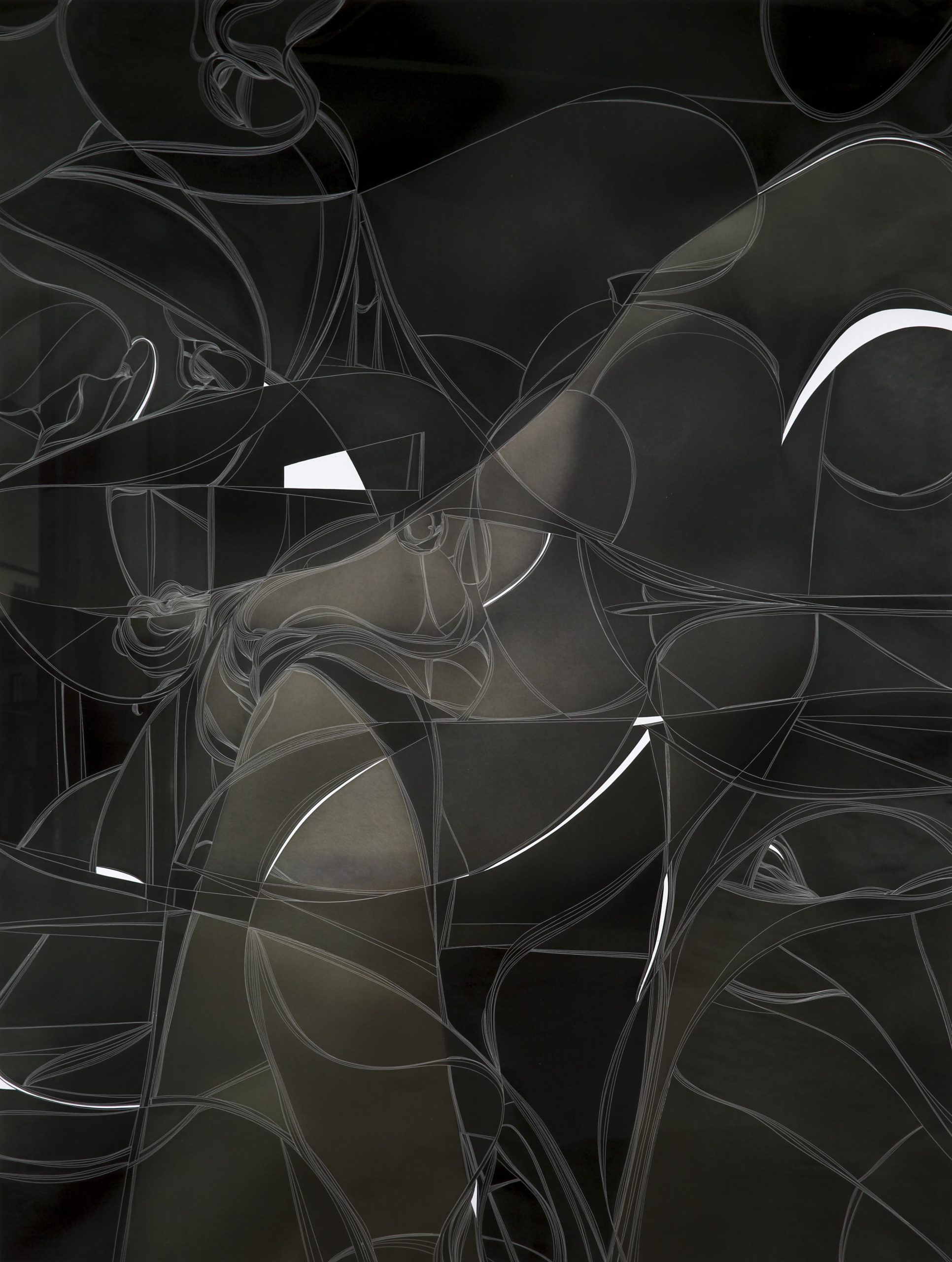
Papa Bravo, 2013, unique carved digital chromogenic print, 64 x 48 1/8 inches
Subjects . . . Right after your exhibit at Edwynn Houk Gallery we went to Matisse’s Red Studio (MoMA) . . . And there was this discourse literally on view at MoMA, between Matisse and the Russian patron, Sergei Shchukin, about a painting which was referred to as The Artist and his Family. . . After having visited New Portraits—a lovely serendipitous moment transcended about subject . . . The artist and their family is a long tradition, and with New Portraits, the subjects are very much you—the artist and his family . . . can you speak about subject—family/friends in your practice both with this current exhibition, as well as Schoener Goetterfunken at Dikeou Collection and in zingmagazine . . .
‘Write what you know’ is the first thing that comes to mind. Migrating alone to New York at 22 has something to do with it. I still yearn to be physically close to my brother, sister, father and mother but they are far away. Besides the occasional trip, letters, faxes and phone conversations, there is a lot lost and removed. So, using pictures of my family in the Netherlands is probably a way of staying connected to them, and my life growing up in Amsterdam. A lot happened in my youth and I remember it all very well, so there is a lot to unpack there. Another thing is that my father and mother made some really great pictures, especially the photographs I ended up using in the Schoener Goetterfunken series.
Those photographs, taken in the beginning of the 1970s, were shot on medium format color negative film with a Rolleiflex camera. Back in the early ‘70s it was expensive and complicated to print color pictures. It was common in that time to photograph in black and white, and everyone would develop and print the pictures in the bathroom of your home. This was quite common. You cannot print a C-print in a domestic setting. Except for one contact print I once saw I don’t think these images were printed. When I found the negatives in a drawer in my father’s house I was happily surprised. When I made contact sheets of them I was blown away. The colors were just crazy good, full spectrum, in my opinion lusher than Kodachrome.
You could feel and see the joy in these pictures. The exhilaration of thin air, blue skies, and some eternal snow on the tops of the mountains and glaciers of Switzerland was just palpable.
The only one missing from the pictures was me. I must have been only 1 ½ or 2 years old and they left me in the care of my aunt and uncle in Holland for a few weeks. Behind the façade of these pretty and joyful pictures lies another world. My parents were having serious marriage troubles, the trips weren’t easy for my sister apparently, and despite the lovely and peaceful image of the world then, there was the Vietnam war, Nixon’s government, rivers on fire in Ohio, threat of nuclear war taking place. I really wanted to use these glorious images but could not find a way in, a suitable way of working. My dense small marks just obscured the very alluring powerful images, and I started to feel that adding any explicit stories or critique was not a good idea to amplify this reality. I finally resolved to stay away from any critique or discord in my additions, and look into works of art that transmitted joy. There is very little in art history that does this successfully, except in my opinion in the Ode to Joy poem by Schiller and the orchestral work of the same name by Beethoven. I proceeded to crank up the volume and play this music while painting on the surface. I made colored spheres appear on and in the emulsion and just brutally amplified the joy that you feel when seeing these captured moments. The colored marks seemingly interact with the people and objects within the photographs creating a world full of wonder and joy.
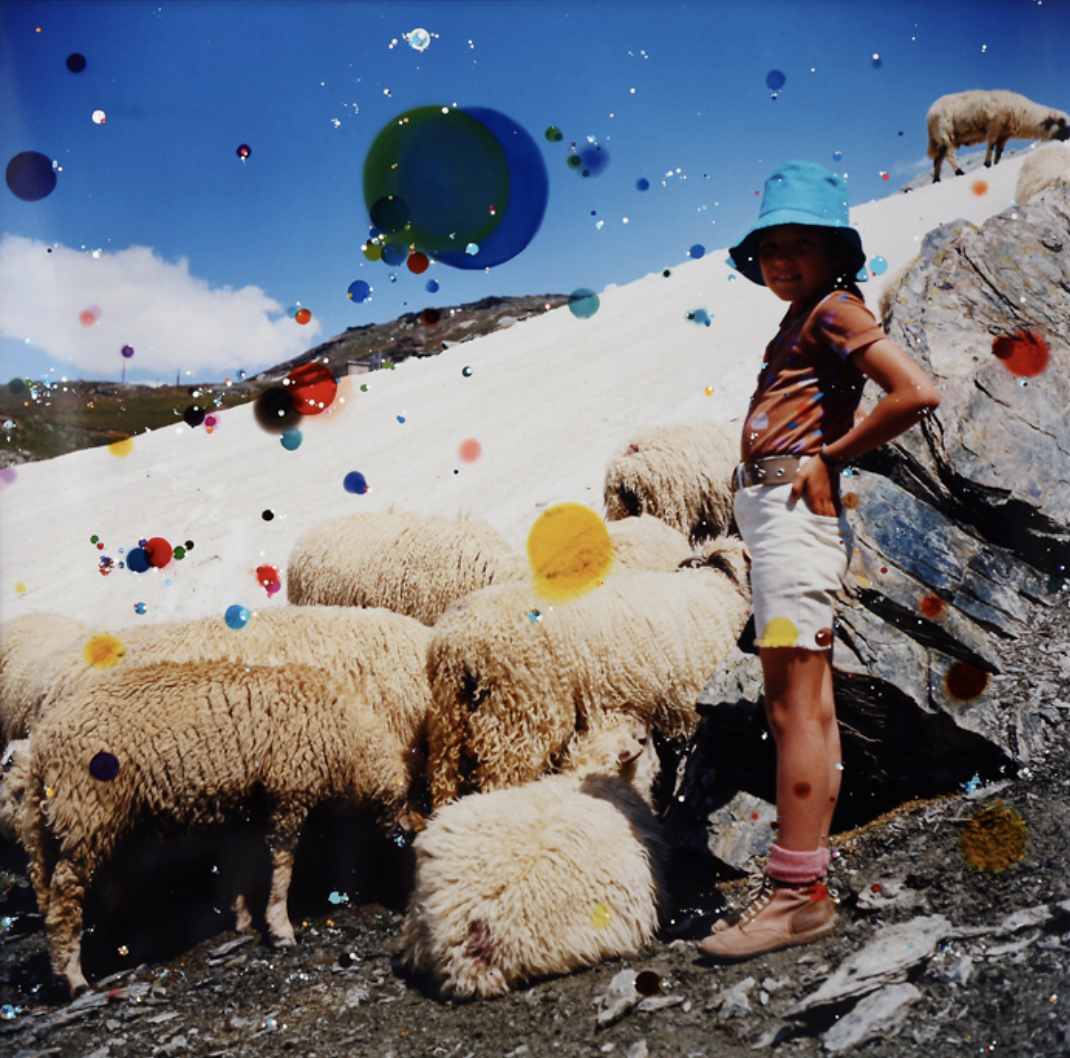
Schöner Götterfunken VII, ‘Joyful As His Suns Are Flying’ (Froh, Wie Seine Sonnen Fliegen), 2011, Unique hand-painted c-print with mixed media, 51” x 50”, courtesy of Dikeou Collection
There’s another connection there, Matisse flattens the space in Red Studio using an overall application of a color to dislocate the viewer’s relationship to space, familiarity, perspective . . . You do a similar thing reasserting the image’s flatness by the application of hand painting on top of a medium where perspective is intrinsic and then further manipulated by the subject’s blurred dislocation.
I love creating an interaction that pulls in all directions simultaneously. I think that this way of thinking and this mode of making art are very fitting and realistic modes of expression. Our reality is necessarily flattened and simplified in our daily life, in order to navigate through our world. In our daily conscious life if you were to completely include the full reality of our experience, our place in space and time, I think you might really lose your balance. Our world, our life, our relationship to other organisms, is infinitely complex. I show a little of that in art using the simplest means. The paper and pen are all I use; no computer or complicated printing is part of my process. In this case the minuscule lines of undulating dots seem to be submerged in the background. From a distance it seems like noise, but coming closer they emerge more clearly. First as lines, or ripples in water. They could also be sound waves, electrocardiograms, seismographic registrations or altitude lines on topographic maps. They slowly emerge and take up more prominence and hover in the foreground. These marks contrast with the very powdery out of focus quality of the pigments printed on the paper. They cannot be taken in at the same time, you can’t focus on far and close at the same time. Still, this happens when you look at these portraits. The result is that in order to observe the prints in their totality you keep having to go back and forth, and even, as I have seen people in the gallery do, move sideways. I also overheard one person wondering out loud if there was a lenticular printing technique involved. I love this strange optical relationship which is forced upon the viewer. Most people, even if they don’t like it or not get it, still spend some time with the works on the walls. I observe people in the gallery going back and forth, squinting their eyes, using their cell phone cameras to zoom in and out. This takes time, and that is a moment that I gain. I get their attention, and I have received this moment in time which they have just given me. Whilst they are trying to figure it out, there is time for a reflective interior process that stretches outside of the scope of the piece that is physically in front of them. In this timeframe there is space to look and reach behind the surface towards an interpretation of the work and the ideas in it.
Mapping and surface, is there a way mapping and surface are plotted . . . Or rather is that organic . . .
I start out with an idea and a direction, and then time and reality intervene. By the time I am done with a work I have veered into a direction I could not have foreseen. When I seriously started painting around 19 years old, I had the sensation that when I would start a painting with an idea in my head. By the end I would have one painting in reality and then still the painting I imagined on the outset existed, so I had two possible directions to go develop from further when I was done. The undulating strings of dots are the result of my hands caressing and tracing the image underneath. It is the registration of the tactile experience, creating a topography which follows the first mark, and goes from there. The first line is like the first ripple in water, and from there the other ripples take shape, echoing the first but slowly morphing into other waves.
Surprise . . . your project in zing, you’ve had several but the one I’m speaking of is with the confetti . . . Spilling out once the plastic covering is opened . . . It was like a prequel for what’s to come . . . Here, with New Portraits, the surprise while less effusive, is stunning, pulling, internal and is created through the play between the depths . . . Of vagueness and precision.
The New Portraits do not seem to be a logical follow up to my previous work. When I started thinking about making portraits I had no idea what else to do, or how to do it. With the benefit of hindsight, it now appears to be a very organic progression. I have combined a few modes of expression, some of which I first used as far back as 1999. Portraiture, and self-portraiture in particular is what I painted when I first got seriously into the idea of being an artist. I had no idea where to start that journey, so I figured I should start close by—and painted myself. This was in 1991. It is funny to see such a return, to see this loop 31 years in the making.
Talk about this kind of unilateral relationship you have with surrealistic game of exquisite corpse . . .
After the first works I made by drawing on photographs with abstract flowing patterns in the very beginning of the 2000s I slowly moved into a more narrative direction. I started drawing small shapes and figures within the flow and lines of the surface of the works. In Ilha das Cobras for example, I have created a layer of swirls of color with Martin’s photo dyes. These dyes are designed to dissolve into the photo emulsion of the prints. They are traditionally used to spot color correct small accidental marks that occur normally in over-sized prints. I apply these horizontally on the print, mixed with water.
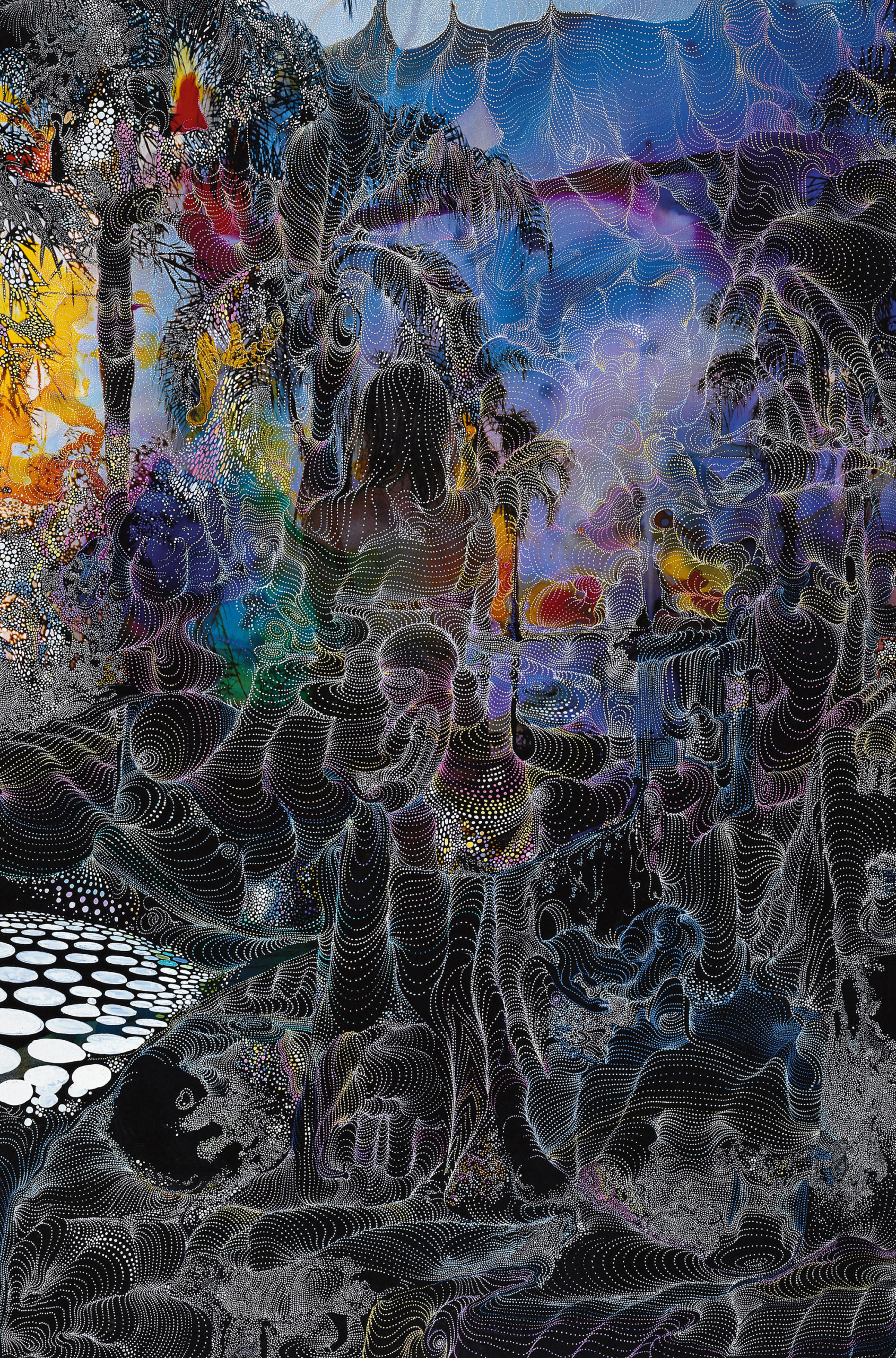
Ilha das Cobras, 2001, unique hand-painted chromogenic print with mixed media, 60 x40 inches
I usually applied a lot of dyes to prints, darkening these works’ overall appearance with deep colors applied to the prints, creating the impression that the figure in the picture is immersed in the surrounding landscape and sky. After this mix of water and dye was all dried up and soaked into the emulsion of the print I worked with an archival gel pen to add small white dots, adding a small baby to the belly of my wife Andrea, who was pregnant at the time I made this work. The image I culled from a small echoscope printout of my son in utero. Later I added vistas, quoted some Hans Bellmer signature drawings of legs and high heels, inserted a horn of plenty. These small drawings which emerge and coalesce upon closer inspection can be read as a rebus, although for a casual viewer it is probably hard to figure out what the meaning is. I continued working in this way for a while. I never really worked much with the exquisite corpse per se, although I did collaborate a few times with the artists Inez & Vinoodh. In this case I would draw my images upon their photograph. On one occasion it was a project for the Callaghan label (then designed by Nicolas Ghesquiere) wherein the model was photographed lying down surrounded by trinkets and a rug specific to my and Inez & Vinoodh’s earlier lives in the Netherlands. These items were jumping off points for my drawings and gestures, giving life to a new kind of Cadavre Exquise of sorts.
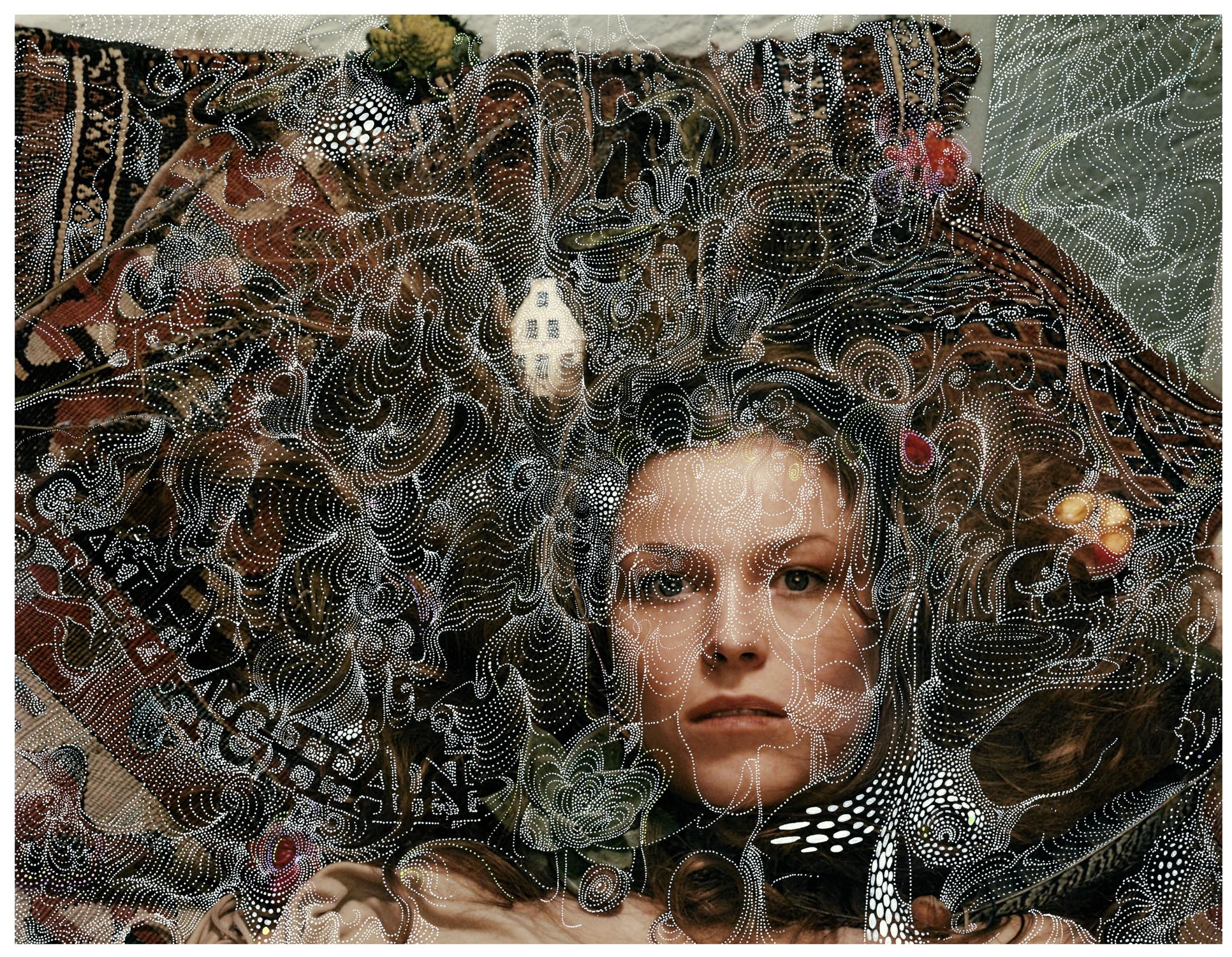
Callaghan 2001, in collaboration with Inez & Vinoodh Unique, hand-painted chromogenic print with mixed media, 15 x20 inches
I feel there is a return to an element of the haunting and that surfeit is countered here by the individuals which brings us back to subject . . . Thoughts . . .
As the series progressed and moved from a series of self-portraits to a series of portraits of family, friends and children of friends the series opened up a bit. The color variation, and the feel of the sitters brought a new life to the work. When it was just me in the very beginning, I was working with the idea of the visualized interior of the individual depicted. In some works, the undulating lines of dots extended slowly outside of the perimeters of the face and, connecting the face to the background and also seemingly extending forward, hovering above and within the face. The movement of the sitter combined with the movement of the camera, compounded by the slow shutter speed in the daylight set up in my studio, created a blur which concretized the idea of connection. The colored backdrop of a door in my Greenpoint studio—and later the paper seamless I used— meshed with the hue of skin and hair, creating a mix of colors. The subjects in the picture were photographed with their eyes closed, and the lines of dots, resembling topographic lines or rippling sound waves are a depiction of an internal isolated experience of time and thought. Sometimes I am stuck in thought, feeling separated from others and my surroundings. The sky and the birds, the smells and sounds of my surrounding are barely registered, which is a dark place to be. The reality is that we are surrounded and connected by the world in all its complexity, and this feeling of isolation is not true. The portraits depict this duality: the people have their eyes closed, seemingly lost in thought, but through movement and drawing the connections are visualized.
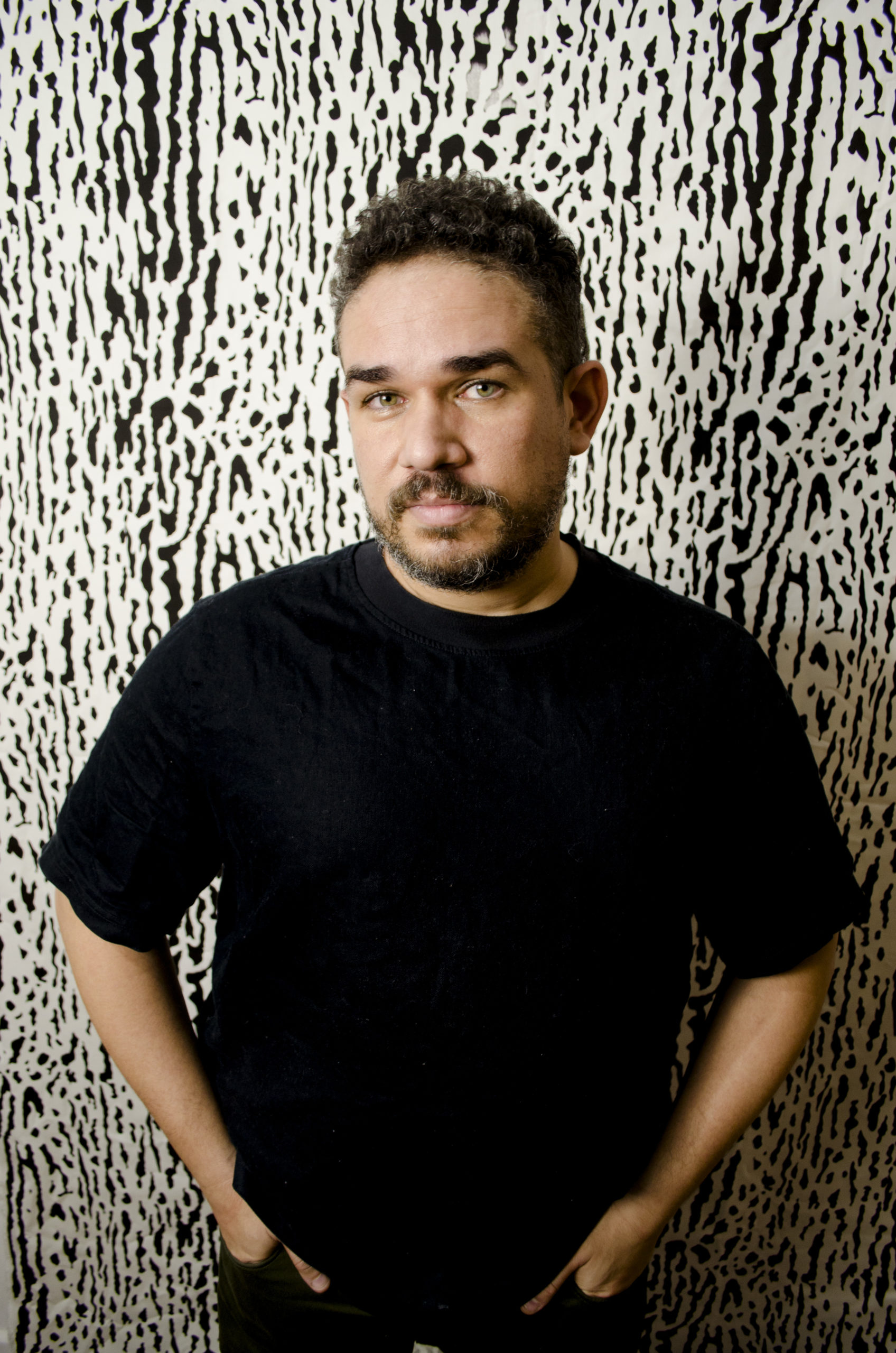
Raphael Fonseca, photo by Randolpho Lamonier
“Who tells a tale adds a tail: Latin America and contemporary art” curated by Raphael Fonseca is on view at Denver Art Museum through March 5, 2023.
Interview by Brandon Johnson
The exhibition title is inspired by a Brazilian proverb “Quem conta um conto, aumenta um ponto” translating to “who tells a tale, adds a point,” which emphasizes the conversational nature of the work. There’s a pun happening in English with “tail” that echoes “tale,” a story that is embellished in nature. In what ways do the artists in this show craft their own narratives, and how do they communally craft the narrative of the exhibition? Is there any embellishment to be found among these narratives?
I feel that the artists craft their narratives in many, many ways. As a curator, I feel that this is the coolest part of working in a group exhibition with so many commissioned works: with an invitation, we can see and collaborate with many different narratives, medias, and points of view. In this sense, the show is no longer (or perhaps it never was, actually) “mine,” but has the authorship of this amazing group of creators. Some of them are interested in very personal narratives, oftentimes related to their biographies and even to their families, while other artists prefer to look at the boundaries between the notion of “story” and “History,” choosing specific episodes and creating very interesting tensions. I feel, now that the show is open, that most of it (and most of my other projects) is very based in this tension between the macro and the micro narratives.
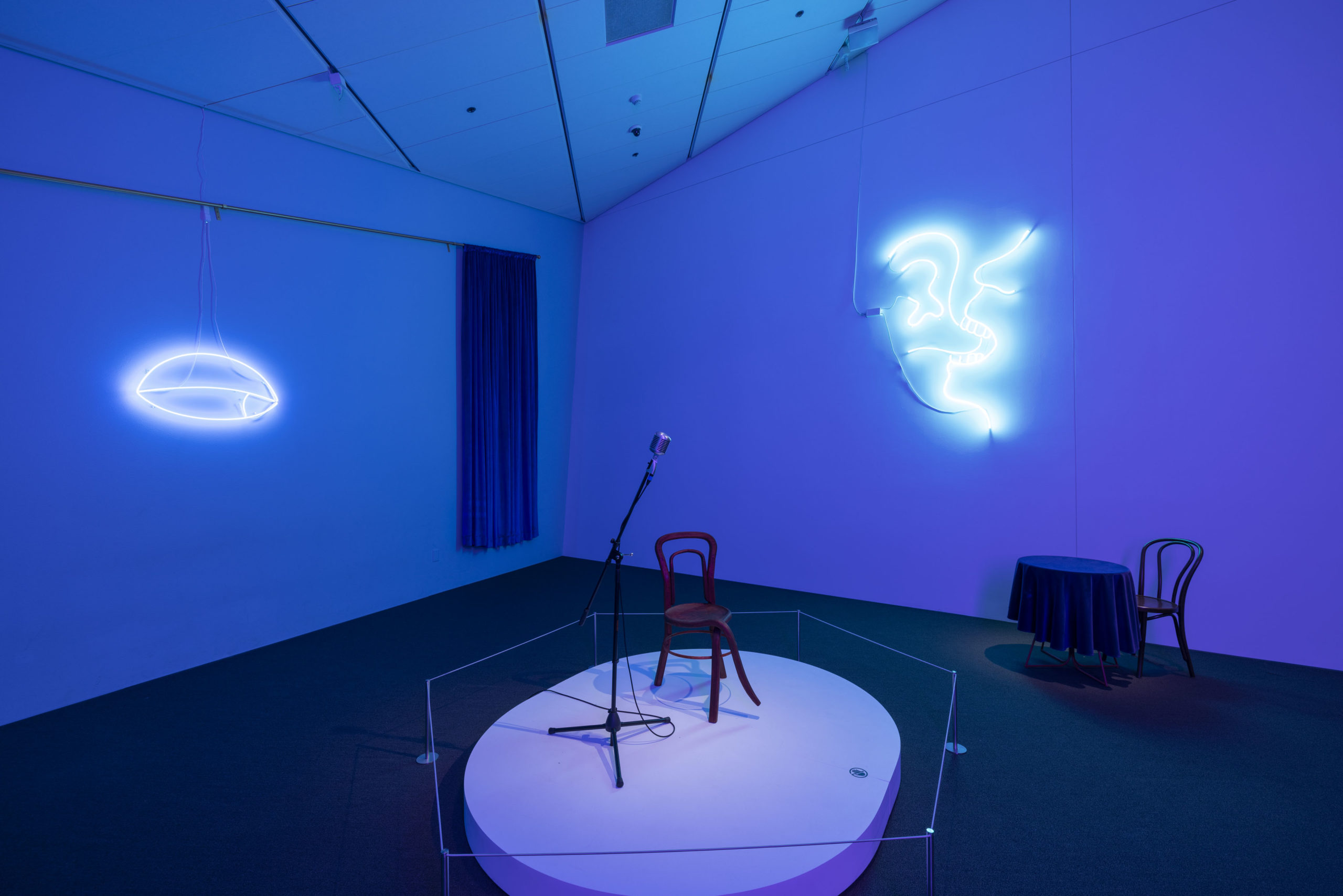
Most of the artwork in the exhibition is commissioned, which is not always the case for museum shows. What was your process in working with the artists to develop the work? Did you already have in mind specific spaces for individual artists within the idiosyncratic spaces of DAM’s Hamilton Building?
The fourth floor of the Hamilton Building is very, very challenging; it is not easy to deal with all its sloped walls, angles, corners, and peculiar ambiances. When I started working on this project, it was clear: we cannot deal with that space like it was a white cube . . . and, in my opinion, it is difficult to simply hang different works by different artists on the same wall or even in the same perimeter. So, yes, I thought that it would be more interesting to “split” the space between the artists—including, of course, the hall close to the elevators and the new amphitheater at the Martin Building. This way each artist could feel freer in their proposals of occupation of these specific segments of the space. After months of discussions, little by little it became clear which artist should occupy which space. It was pretty organic.
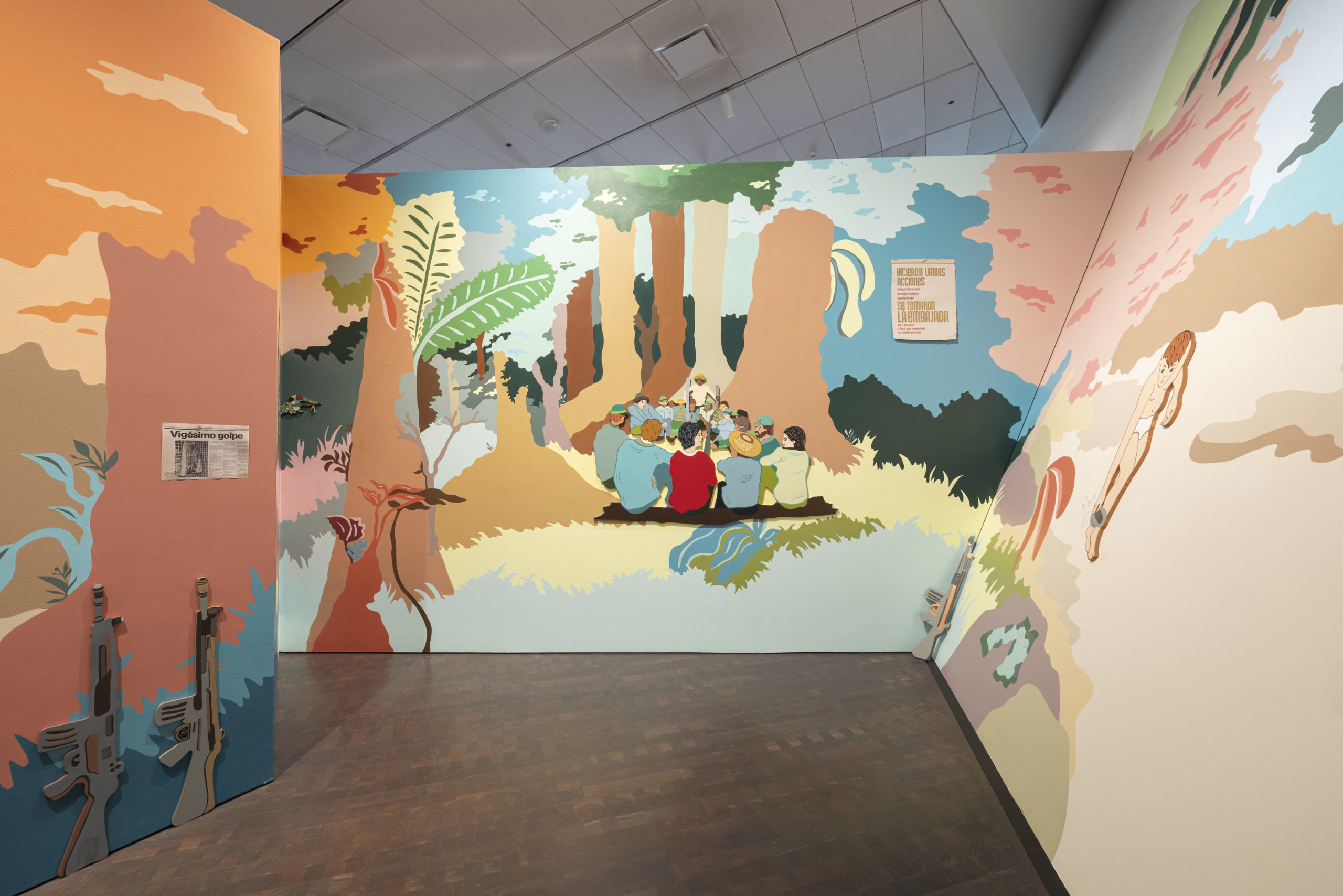
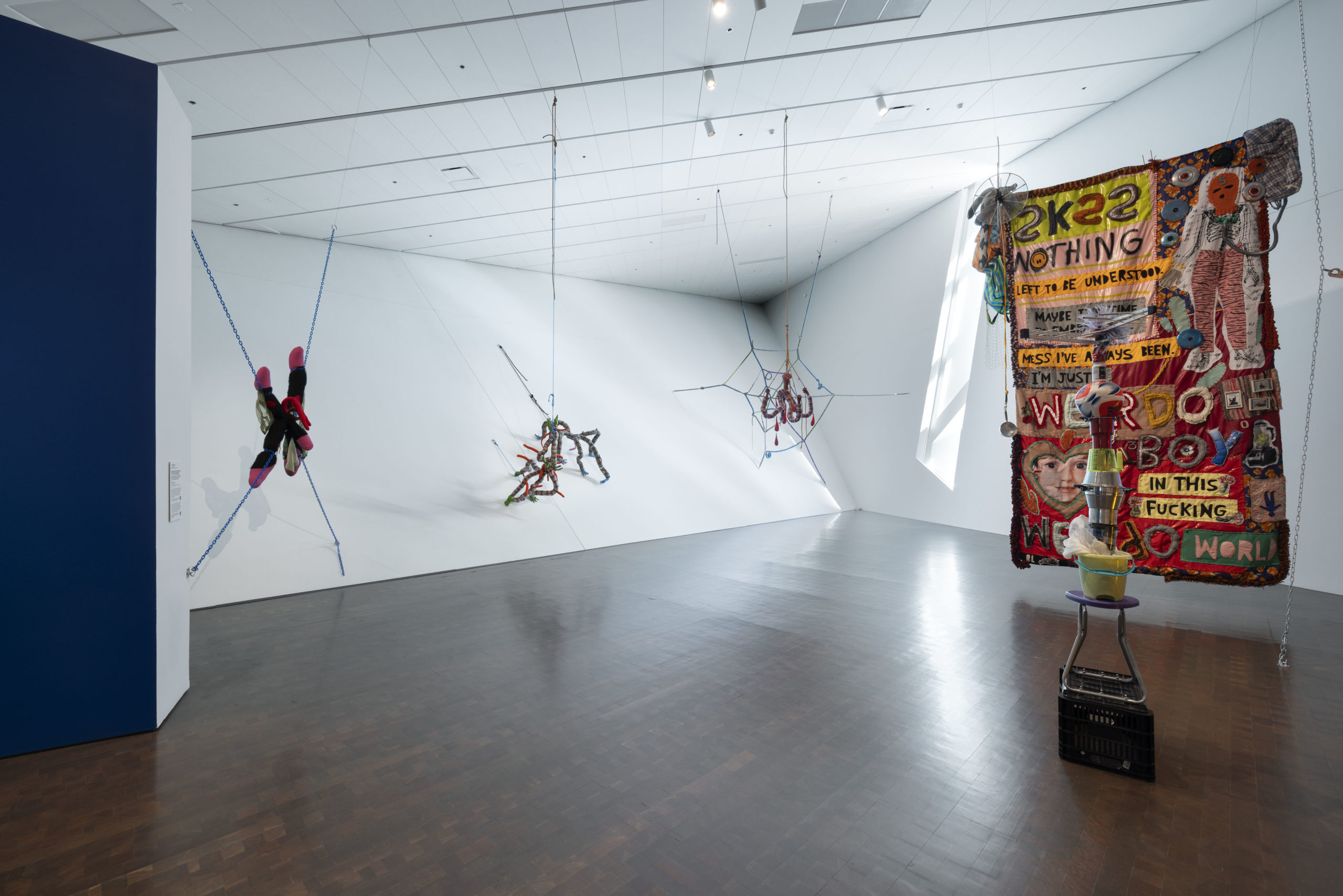
I noticed that while the artists are originally from a variety of Latin American countries, that many of them are currently based in the United States or Europe. Do you believe this geographical and cultural distance gives further perspective to the artists in developing the narratives of their work than if they continued to work in their countries of origin?
Absolutely. I feel also that this is a common characteristic of this generation of artists—a generation I am also part of. Many of the artists, like Claudia Martínez Garay and Tessa Mars, studied abroad— they studied in Amsterdam, at the Rijksakademie—and there they stayed. We discussed a lot about this topic: how does the fact that you are not living in Latin America anymore influence your work? How do certain international communities look at your work? Does it make sense to still make works that quote and discuss explicitly “Latin American culture” if these artists have not been living there for years? The discussion is long and multilayered, but I feel that some of these artists avoid any approach to their work that could put them into a box, locking further interpretations of their research.
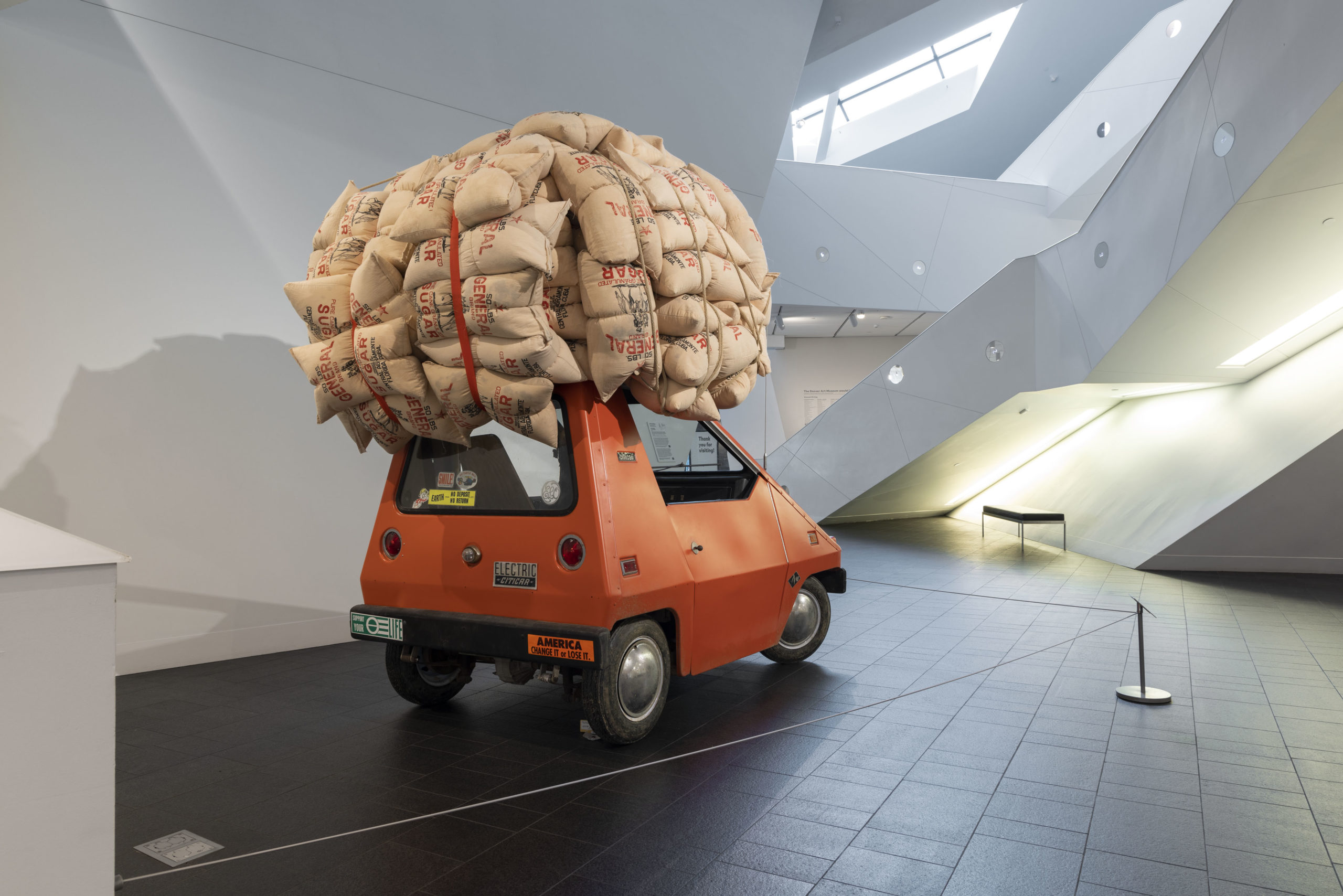
The 19 artists in the exhibition are all of the millennial generation. What significance does this age group hold for you in relation to the production of art? Is it an emphasis on technology and identity?
To work with this generation means to work with artists that were born before the internet was everywhere; even with the artists ranging in age from 26 to 41 years old in the exhibition, we all remember the day that someone told us about internet, social networks, mobile phones, and more. This common point certainly brings to the artist a certain approach of appropriating previously existent images, storytelling, and all the boundaries between that which can be considered “truth” and “lie.” All these aspects seem very clear in the show to me. More than that, I also think it is a great opportunity to gather artists that, in most of the cases, never had the opportunity to show their work in a museum in the United States. To some of them this is not only their first ever exhibition in the country, but also the first time they even travelled here.
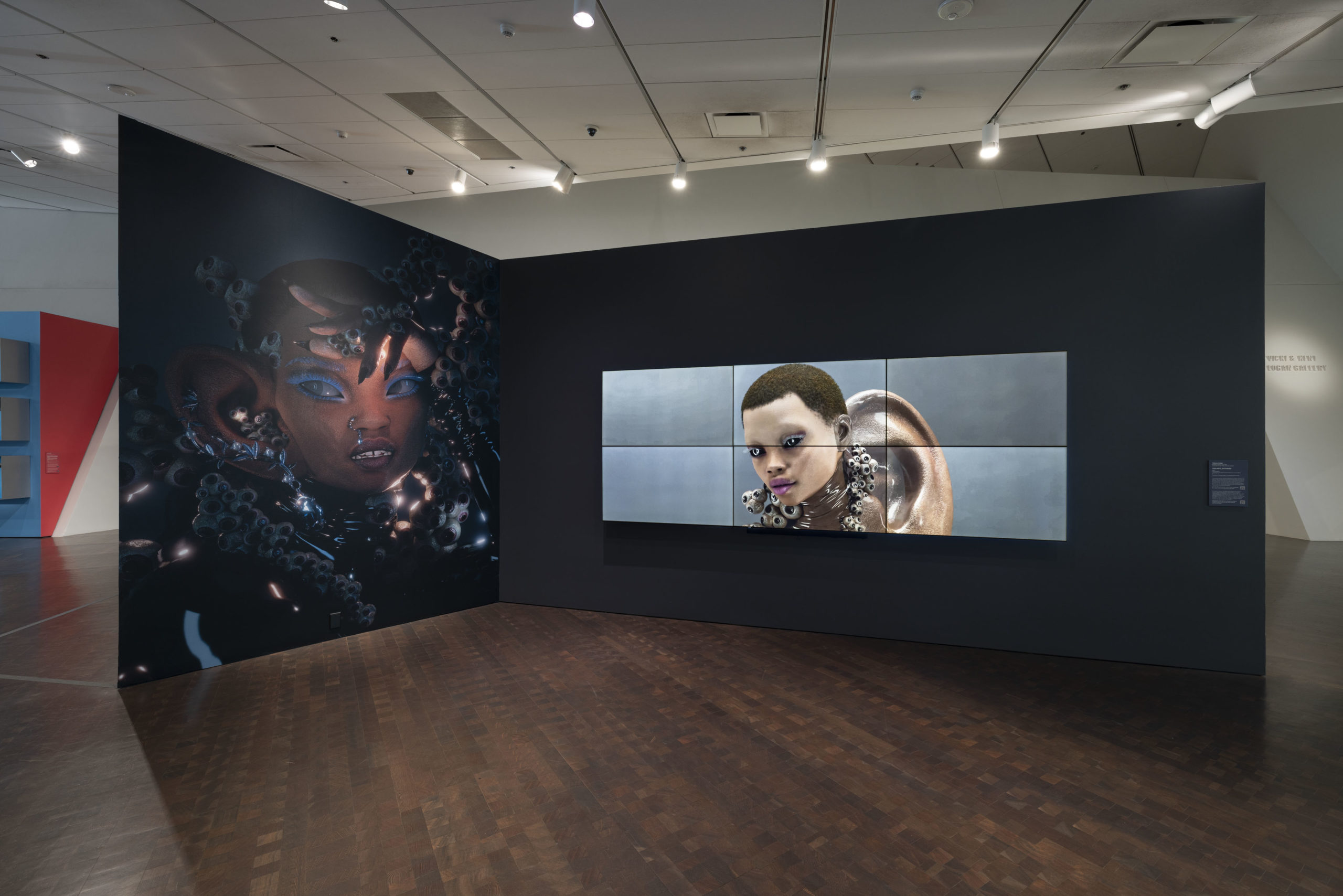
When you first conceived of this exhibition, did you have it in mind to feature artists who had never shown in United States museums previously? If so, what did you hope to achieve in introducing these artists to an audience in Denver, and the United States more generally?
Yes, I had that in mind—it is something that I always try to do in all my projects. It doesn’t make sense to me, as a curator, to only work with artists that are very well known and full of recognition in a global perspective; I think it is part of my responsibilities as a curator to take the opportunity to always have a balance of artists in different institutional stages in their careers. Naturally, then, these reflections came to my mind during the investigation process that resulted in the show. I hope that the exhibition can contribute to a broader reflection on what the idea of “Latin American art” could mean nowadays—not only in Denver and in the United States, but also in a broader, international perspective. If people visit the show and felt that somehow the idea of “Latin America” can be read as a fiction full of contradictions and multilayered interpretation, I think I have reached some of my goals. If the artists in the show are, in the future, invited to do other projects in the United States—not only, I must say, projects dedicated to the region of Latin America, but also other exhibitions related to contemporary art in a wider perspective—I also will feel that I have reached my goals. Curating is all about sharing, and I really hope that “Who tells a tale adds a tail” can be seen as a starting point to other art professionals (curators, directors, professors, collectors, etc) share these artists’ research in different opportunities.
